How to Make a Resume in 2024 | Beginner's Guide

For most job-seekers, a good resume is what stands between a dream job and Choice D. Get your resume right, and you’ll be getting replies from every other company you apply to.
If your resume game is weak, though, you’ll end up sitting around for weeks, maybe even months, before you even get a single response.
So you’re probably wondering how you can write a resume that gets you an interview straight up.
Well, you’ve come to the right place!
In this guide, we’re going to teach you everything you need to know about how to make a resume, including:
- The 8 Essential Steps to Writing a Resume
- 11+ Exclusive Resume Tips to Up Your Resume Game
- 27+ Real-Life Resume Examples for Different Professions
….and more!
So, let’s dive right in.

How to Make a Resume (The Right Way!)
Before we go into detail about how you should make a resume, here’s a summary of the most important steps and tips to keep in mind:

- Choose a resume format carefully. In 99% of cases, we recommend the reverse-chronological format .
- Add the right contact details. Leave your headshot out and make sure to include your job title , a professional email address, and any relevant links. (E.g.: your LinkedIn profile , online portfolio, personal website, etc.).
- Write an impactful resume summary. Unless you’re an entry-level professional, always go for a resume summary. If you do it right, it’s your chance to get the hiring manager to go through the rest of your resume in detail.
- Pay attention to your work experience section. Take your work experience section from OK-ish to exceptional by tailoring it to the job ad, making your achievements quantifiable, and using action verbs and power words.
- Add the right skills for the job. Keep this section relevant by only including the hard and soft skills that are required for the position.
- Keep your education short and to the point. Your most recent and highest degree is more than enough for a strong education section. You only need to add more details here if you’re a recent graduate with barely any work experience.
- Leverage optional resume sections. Optional sections like languages, hobbies, certifications, independent projects, and others can set you apart from other candidates with similar skills and experience.
- Include a cover letter. That’s right, cover letters matter in 2024, and the best way to supplement your resume is by adding an equally well-crafted cover letter to your job application. To make the most of it, check out our detailed guide on how to write a cover letter .
To get the most out of our tips, you can head over to the resume builder and start building your resume on the go as you read this guide.
New to resume-making? Give our ‘7 Resume Tips’ video a watch before diving into the article!
#1. Pick the Right Resume Format
Before you start filling in the contents of your resume, you have to make sure it’s going to look good.
After all, the first thing hiring managers notice is what your resume looks like, and then they start reading it. So, this is your best chance to make a great first impression.
Start by choosing the right resume format.
There are three types of resume formats out there:
- Reverse-chronological. This is by far the most popular resume format worldwide and, as such, it’s the best format for most job-seekers.
- Functional. This resume format focuses more on skills than work experience. It’s a good choice if you’re just getting started with your career and have little to no experience in the field.
- Combination. The combination resume format is a great choice for experienced job-seekers with a very diverse skill set. It’s useful if you’re applying for a role that requires expertise in several different fields and you want to show all that in your resume.
So, which one should you go for?
In 99% of cases, you want to stick to the reverse-chronological resume format . It’s the most popular format and what hiring managers expect to see. So, in the rest of this guide, we’re going to focus on teaching you how to make a reverse-chronological resume.

Fix Your Resume’s Layout
With formatting out of the way, let’s talk about your resume’s layout , which determines the overall look of your resume.
Does it look organized or cluttered? Is it too short or too long? Is it boring and easy to ignore, or is it reader-friendly and attention-grabbing?
Here are some of the best practices you should apply:
- Stick to one page. You should only go for a two-page resume if you have decades of experience and you’re sure the extra space will add significant value. Hiring managers in big companies get hundreds of applications per job opening. They’re not going to spend their valuable time reading your life story!
- Add clear section headings. Pick a heading and use it for all the section headers so the hiring manager can easily navigate through your resume.
- Adjust the margins. Without the right amount of white space, your resume will end up looking overcrowded with information. Set your margins to one inch on all sides so your text fits just right on the page.
- Choose a professional font. We’d recommend sticking to a font that’s professional but not overused. For example, Ubuntu, Roboto, or Overpass. Avoid Times New Roman, and never use Comic Sans.
- Set the correct font size. As a rule of thumb, go for 11-12 pt for normal text and 14-16 pt for section titles.
- Use a PDF file. Always save your resume as a PDF file, unless the employer specifically requests otherwise. Word files are popular, but there’s a good chance they’ll mess up your resume’s formatting.
Another thing you need to consider in terms of your resume’s layout is whether you’re going for a traditional-looking resume template or something a bit more modern :

If you’re pursuing a career in a more traditional industry, like law , banking , or finance , you might want to stick to the first.
But if you’re applying to a tech company where imagination and innovation are valued, you can pick a more creative resume template .
Want to Save Time? Use a (Free) Resume Template
Anyone who’s ever tried creating a resume from scratch knows how boring the formatting can be.
Before you can even start filling in the contents, you need to tweak the margins, adjust font sizes, and make sure everything fits into one page while still looking good.
What if you could skip past all that and still create a compelling resume?
Try one of our free resume templates . They’re pre-formatted, so all you have to do is fill in the contents.
They’re also created in collaboration with recruiters from around the globe, ensuring that the templates are visually appealing and ATS-friendly!
See for yourself how one of our templates compares to a resume created in a standard text editor:

#2. Add Your Contact Information
Now that we’ve got all the formatting out of the way, let’s get into what your resume is all about— the information you put on it .
The first thing you want to do when filling out the contents of your resume is to add your contact information .
This section is pretty straightforward but crucial. Your contact details belong at the top of your resume in a designated resume header , so the hiring manager can easily find them.
Even if everything else about your resume is perfect, that all flops if you misspell your email address or have a typo in your phone number. If the hiring manager can’t contact you, it’s a missed opportunity.
So, double-check, and even triple-check your contact information section and make sure everything is factually correct and up-to-date.
Must-Have Information
- Full name. Your first and last name should stand out at the top of your resume.
- Email address. Stick to an address that’s professional and easy to spell, like a combination of your first and last name. (E.g.: [email protected])
- Phone number. Add a reliable number where the hiring manager can easily reach you.
- Location. Add your city and state/country. If you plan to relocate for the job or want a remote position, specify it on your resume.
Optional Information
- Job title. Add your professional title underneath. Write it down word for word, whether it’s “Digital Marketing Specialist” or “Junior Data Scientist.” Just don’t make up job titles like “Marketing Wizzard” or “Data Manipulator.” They’re not quirky; they’re just unprofessional.
- LinkedIn profile . We recommend that you include a link to your updated LinkedIn profile since over 77% of hiring managers use the platform when evaluating a candidate.
- Relevant links. Include links to personal websites or any social media profiles that are relevant to your field. For example, a developer could include a Github profile, while a graphic designer could link their Behance or Driblle account, and so on.
- Date of birth. Unless this is specifically required in the job ad, the hiring manager doesn’t need to know how old you are. It’s not important for their decision-making, and at worst, it might lead to age-based discrimination.
- Unprofessional email address. Your quirky, old high school email address doesn’t belong on your resume. Instead of [email protected] , go for a [email protected] type of address.
- Headshot. (USA, UK or Ireland) Depending on the country where you’re applying, it might even be illegal to include a picture of yourself on your resume . While it’s the norm to include a picture in most of Europe and Asia, always check the regulations for each specific country or industry you’re applying to.
All clear? Good! Now, let’s look at what a great example of a resume's contact information section looks like:

#3. Write a Resume Headline (Summary or Objective)
It's no secret that recruiters spend an average of less than seven seconds on a resume .
When you receive hundreds, if not thousands, of applications daily, it's physically impossible to spend too much time on each.
So, what the hiring managers do to go through resumes more effectively is to skim through each resume and read it in depth only if it piques their interest.
This is where the resume headline comes in.
Placed right next to (or underneath) your contact information, this brief paragraph is the first thing the hiring manager is going to read on your resume.
Now, depending on how far along in your career you are, your resume headline can be either a resume summary or a resume objective.

So, how do you choose between a resume summary and a resume objective? Here’s all you need to know:
Resume Summary
A resume summary, as the name suggests, is a two to three-sentence summary of your career so far. If done right, it shows that you’re a qualified candidate at a glance and gets the hiring manager to give you a chance.
Here’s what your resume summary should include:
- Your job title and years of experience.
- A couple of your greatest professional achievements or core responsibilities.
- Your most relevant skills for the job.
Here’s an example of a well-written resume summary:
Experienced Java Developer with 5 years of experience in building scalable and efficient applications. Contributed to a major project that enhanced application performance by 25%. Strong background in Spring Framework and microservices. Aiming to apply robust coding skills to develop innovative software solutions at XYZ Tech Solutions.
Unless you’re a recent graduate or amid a career change, we recommend you stick to a resume summary. Otherwise, a resume objective might be a better option for you.
Resume Objective
A resume objective is supposed to express your professional goals and aspirations, academic background, and any relevant skills you may have for the job.
It communicates your motivation for getting into a new field, so it’s the go-to headline for recent graduates and those going through a career change. As with a resume summary, a resume objective should be brief—around two to four sentences long.
So, here’s what it would look like if you’re a student:
Hard-working recent graduate with a B.A. in Graphic Design from New York State University seeking new opportunities. 3+ years of practical experience working with Adobe Illustrator and Photoshop, creating illustrations and UX/UI design projects. Looking to grow as a designer and perfect my art at XYZ Design Studio.
Or, on the other hand, if you’re going through a career change, it might look more like this:
IT project manager with 5+ years of experience in software development. Managed a team of developers to create products for several industries, such as FinTech and HR tech. Looking to leverage my experience in managing outsourced products as a Product Owner at Company XYZ.
#4. Prioritize Your Work Experience
The most important part of your resume is your work experience.
This is where you get to sell yourself and show off your previous accomplishments and responsibilities.
If you manage to master this section, you’ll know most of what’s there to know about how to make a resume.
There are plenty of good practices for writing your work experience . But before we dive into all the nits and grits, let's start with the basics.
The standard format for each work experience entry is as follows:
- Job title/position. Your job title goes on top of each work experience entry. When the hiring manager looks at your resume, you want them to know, at a glance, that you have relevant work experience for the job.
- Company name/location/description. Mention the name of the employer and the general location, such as the city and state/country where you worked. In some cases, you may also want to briefly describe the company, like when the organization isn’t particularly well-known.
- Dates employed. Add the approximate timeframe of your employment at each company. You don’t need to give exact dates since the standard format for this is mm/yyyy.
- Achievements and responsibilities. This is the core of each work experience entry. Depending on your field, you want to list either your achievements or responsibilities. List them in bullet points instead of paragraphs, so they’ll be easier to read.
Here’s a real-life example:

Your work experience entries should always be listed in reverse chronological order , starting with your most recent job and working your way back into the past.
Now that you know how to list your experience, we’re going to show you how to write about it in a way that makes you stand out from the competition, starting with:
Are you a student with no work experience? We’ve got you covered. Check out our guide to writing a resume with no experience here.
Focus on Achievements Whenever Possible
One of the most common resume mistakes is only listing responsibilities in your work experience section.
Here’s the thing—in most cases, the hiring manager knows exactly what your job responsibilities are.
For example, if you’re a sales manager, your responsibilities would be:
- Reach out to potential clients over the phone or email.
- Maintain relationships with existing company clients and upsell relevant products.
- Tracking and reporting on leads in CRM.
Coincidentally, this is also the same list of responsibilities for every sales manager out there. So, 90% of all other resumes probably mention the same thing.
To stand out from the competition, you want to focus on writing achievements in your resume instead. These can be how you helped your previous company grow, reach quarterly quotas, and so on.
Let’s compare how responsibilities hold up next to achievements for the same job:
- Exceeded sales team KPIs by 30%+ for 3 months straight.
- Generated over $24,000 in sales in 1 month.
- Generated leads through cold-calling
- Managed existing company clients
Keep in mind, though, that in some fields, there just aren’t that many achievements you can mention. Let’s say you’re a warehouse worker .
Your day-to-day responsibilities probably include:
- Loading, unloading, and setting up equipment daily.
- Packaging finished products and getting them ready for shipping.
- Assisting in opening and closing the warehouse.
In fields like this, it’s pretty hard to distinguish yourself through achievements, so it’s okay to stick to responsibilities instead. You can still make them shine by following the rest of our advice about listing your work experience.
Keep in mind, though, that in some fields, there aren’t that many achievements you can mention. Let’s say you work in a warehouse. Your day-to-day responsibilities probably involve:
- Loading, unloading and setting up equipment on a daily basis.
- Package finished product and get it ready for shipping.
- Assist in opening and closing the warehouse.
In such fields, it’s pretty hard to distinguish yourself, so it’s totally OK to stick to responsibilities instead.
Tailor Your Resume to the Job
Tailoring is what sets an amazing resume apart from an okay one.
Hiring managers don’t need to know about every single job you’ve ever worked at or every single skill that you have.
They only want to know about your jobs, experiences, or skills that are relevant to the role you’re applying for.
For example, if you’re applying for a job doing Google Ads, you don’t need to talk about your SEO internship from eight years ago.
By focusing your resume on whatever is important for the specific role, you’re a lot more likely to stand out and catch the hiring manager’s attention.
Let’s take a look at an example of a job ad:

As you can see, we’ve highlighted the most important requirements.
To tailor your resume accordingly, you just need to mention how you meet each of these requirements in your resume.
You can highlight your relevant achievements and qualifications in different parts of your resume, such as:
- In your resume summary, where you should recap your years of experience.
- Throughout your work experience section, where you should list achievements and responsibilities that reflect your social media marketing experience.
- In your education section, where you can let the hiring manager know you have the degree that they’re looking for.
Include the Right Amount of Work Experience
If you’ve got over a decade’s worth of work experience, you’re probably wondering whether all of it belongs on your resume. In most cases, you’d end up writing a novel if you listed everything you’ve ever done, and that’s not how long a resume should be .
If you’re new to the job market, on the other hand, you probably don’t have any experience, and you’re wondering what you could even add to this section.
So, here’s how much information your resume should include, depending on your level of experience:
- No experience. If you’re looking for your first job , you won’t have any work experience to fill this section with. So, you can either keep it empty and focus on all the other sections or fill it up with any experience gained in student organizations, extracurricular activities, volunteering, and other projects.
- Entry-level. List all your work experience so far. While some of it won’t be relevant, it can still show the hiring manager that you do have some actual work experience.
- Mid-level. Only mention relevant work experience to the position you’re applying for. There’s no need to waste space on jobs that aren’t related to what you’re after.
- Senior-level. List up to 15 years of relevant work experience, tops. If your most recent experience is as a marketing executive , the hiring manager doesn’t care how you started your career as a junior marketing specialist 23 years ago.
Consider Applicant Tracking System (ATS) Software
Did you know that over 70% of resumes don’t even make it to the hiring manager ?
Most companies these days use ATS to evaluate hundreds of resumes instantaneously and automatically filter out the ones that don’t meet their criteria.
For example, if a resume doesn’t mention a specific skill or isn’t formatted correctly, the ATS will automatically reject it.

Fortunately, there are some easy ways to make an ATS-friendly resume .
Here are a couple of tips to help you get past those pesky robots:
- Stick to one page. Sometimes employers set a limit on how long a resume should be. This means that if your resume is longer than one page, it might get automatically disqualified.
- Incorporate keywords. Tailoring your resume to the job helps a ton with beating the ATS. Just carefully read the job description to find hints for what the ATS will be looking for. Then, whenever you find keywords related to your responsibilities and achievements, make sure to include them in your work experience section.
- Use an active voice. Passive voice is too vague and unclear, so make sure to use active voice as much as possible when describing your previous jobs. (E.g.: “Managed a team of ten people,” instead of “ A team of ten people was managed by me.” )
- Leverage powerful action words. Instead of starting each of your sentences with “was responsible for," make your work experience impactful by using words that can grab attention. Saying that you “spearheaded” or “facilitated” something sounds a lot more impressive than “helped.”
Want to make sure your resume formatting passes the ATS test? Choose one of our tried and tested ATS-friendly resume templates , and you’ll be good to go!
#5. List Your Education
The next section on your resume is dedicated to your academic qualifications. Let’s start with the basics!
Here’s how you should format the education section on your resume :
- Program Name. Your major and degree type should be listed. (E.g.: “B.A. in Business Administration” )
- University Name. Add the name of the institution. (E.g.: “New York State University” )
- Dates Attended. Use a mm/yyyy format for the dates you attended. (E.g.: “08/2008 - 06/2012” )
- Location. If your university is less well-known, you can also add the location. (E.g.: “Stockholm, Sweden” )
- GPA. Use the appropriate grading system for the country you’re applying to work in. (E.g.: In the USA, it would be “3.9 GPA” )
- Honors. Add any honors and distinctions you’ve been given. (E.g.: Cum Laude, Magna Cum Laude, Summa Cum Laude )
- Achievements. You can mention interesting papers you’ve written, projects you’ve done, or relevant coursework you’ve excelled in.
- Minor. “Minor in Psychology”
Pretty simple, right? Now let’s see what an education section looks like in practice:

This example includes all the necessary information, plus an eye-catching award and relevant classes this candidate has taken.
Resume Education Tips
Now that you know how to list your education on your resume, let’s take this section to the next level.
Just follow these expert tips:
- If you’re making a resume as a student and don’t have any work experience yet, you can list your education section at the beginning of the page instead of work experience.
- You can add your expected graduation date if you’re still pursuing your degree.
- If you already have relevant work experience, just keep this section short and sweet. Recent graduates can expand on their education more and add optional information like projects, classes, academic achievements, etc.
- Always list your degrees in reverse chronological order, starting with your highest degree on top. Your highest and most recent degree is usually enough, so if you have a Master’s degree that’s relevant to the job, there’s no need to mention your earlier degrees.
- Don’t add your high school degree to your resume if you already have a university degree. It doesn’t have as much weight, and you can use the space for something else.
- Only mention your GPA if you had an impressive academic career. Anything below a 3.5 GPA doesn’t need to be on your resume.
Are you in the process of applying for college? Check out our guide to writing a college application resume to wow that admissions officer!
#6. Emphasize Your Know-How in the Skills Section
After your work experience, your skills are the first thing the hiring manager is going to look for. In fact, together, work experience and skills make up 90% of the hiring decision .
So, this is the place where you want to mention all the know-how that makes you the perfect candidate for the job.
There are two types of skills you can include when writing your resume:
- Hard Skills. These are measurable abilities. What you can list here can be anything from coding in Python to knowing how to cook Thai cuisine.
- Soft Skills. Also known as personal skills, these are a mix of communication skills , personal traits, career attributes, and more. They can include leadership, critical thinking, and time management , just to name a few.
Your resume should always cover both hard skills and soft skills . Here’s an example in action:

Now, let’s discuss how you should list your most important skills on your resume.
There are a few essential steps you need to follow:
Always List Hard and Soft Skills Separately
Your resume should be easy and neat to navigate. The hiring manager shouldn’t have to waste time looking for a specific skill because you didn’t separate it into the appropriate subsection.
So, just create separate categories for your hard and soft skills.
Depending on your field, you could customize the name of your “hard skills” subsection to something like “technical skills," “marketing skills," or something else related to your field.
Let’s look at an example of what skills look like on a project manager’s resume :
Methodologies & Tools
- Agile Methodology
- SCRUM Framework
- Waterfall Project Management
- Microsoft Project
- Critical Path Method (CPM)
- Earned Value Management (EVM)
- Risk Management
Soft Skills
- Team Management
- Conflict Resolution
- Negotiation
Tailor Your Skills to the Job
You might have some awesome skills, but the hiring manager only needs to know about the ones that are relevant to the job.
For example, if you’re applying for a job as an accountant, your gourmet chef skills shouldn’t be on your resume.
Look at the job ad and list at least two to three essential skills you have that are required for the role. Remember—there’s no need to list every skill you have here; just keep it relevant.
Qualifications:
- Bachelor’s degree or higher in Graphic Design or a related field.
- Tech-savvy, with some background in CMS systems such as WordPress.
- Thrives in a stressful environment and juggles multiple tasks and deadlines.
- Strong organizational and time management skills.
- Excellent communication skills.
- Self-reliant, with the ability to manage their own work.
- A can-do attitude and an outside-the-box thinker.
- Proficient in Adobe Photoshop, InDesign, Illustrator, Keynote, and Pages.
- Basic understanding of Office software such as Microsoft Word, Excel, PowerPoint, and Outlook.
So, the must-have hard skills here are Photoshop, InDesign, Illustrator, Keynote, and Pages. Other good computer skills to have are WordPress or similar CMS systems.
While you can also mention Word, Excel, PowerPoint, and Outlook, it’s pretty much assumed that you know how to use them since they’re required for most office jobs.
List Hard Skills with Experience Levels
For each hard skill you list on your resume, you should also mention your proficiency level. This tells employers what they can expect from you and how much training you might need.
- Beginner. You have some experience with the skill, whether it’s from some entry-level practice or classroom education.
- Intermediate. You’ve used the skill in a work environment with good understanding.
- Advanced. You’re the go-to person for this skill in your office. You can coach other employees, and you understand the skill at a high level.
- Expert. You’ve applied this skill to more than a handful of different projects and organizations. You’re the go-to person for advice about the skill, not just in your office but even amongst some of the best professionals in your field.
Just make sure to never lie about your actual skill level. Even if you get the job, once you need those skills you exaggerated, it will be pretty awkward for both you and your employer.
Include Transferable Skills
These are the types of skills that are useful for almost any job out there.
Transferable skills can be both soft skills (e.g.: teamwork, creativity, problem-solving skills, and others) and hard skills (MS Office Suite, HTML, writing, etc.)
Whatever job you’re applying to, chances are you have transferable skills from your experience that can come in handy one way or another. So, feel free to include them, even if they’re not specifically required for the position.
Not sure which skills to mention on your resume for your specific field? Check out our list of 101+ essential skills for inspiration!
#7. Leverage Optional Resume Sections
The sections we’ve covered so far are must-haves for any resume. They’re the bread-and-butter for any job application, and if you get them right, you’ll land any job you apply to.
But if you have some leftover space, there are a few optional sections you can choose from to give your resume a boost!

Are you bi-lingual? Or even better – multi-lingual? You should always mention that on your resume!
Even if the position doesn’t require you to know a specific language, it can still come in handy at some point. At the end of the day, it’s always better to know more languages than less.
To list languages in your resume , just write them down and assign them the appropriate level:
- Intermediate
You can also use the Common European Framework of Reference for Languages (CEFRL) or the American Council on the Teaching of Foreign Languages (ACTFL) proficiency scales.
As a given, you should never lie about your language skills. You never know—your interviewer might turn out to be fluent in the language or even be a native speaker!
Hobbies and Interests
If you want to spice up your resume, hobbies and interests could be just what you need.
While this section isn’t a game-changer, it can help the hiring manager see who you are as an individual.
For example, if you listed “teamwork” as one of your skills, hobbies like team sports can back up your claim.
And who knows? Maybe you and your interviewer have some hobbies or interests in common!
Volunteering Experience
If you’re the type of person who devotes their free time to helping others while expecting nothing in return, chances are that you’re the type of employee who’s in it for more than just the money.
Seeing volunteer experience on your resume tells hiring managers that you’re a loyal employee who’s after something meaningful.
Several studies show that listing your volunteer experience can boost your chances of getting hired, especially if you have little to no work experience.
Certifications
Hiring managers love candidates who invest in themselves, and that’s exactly what they see when you list certifications on your resume .
If you value continuous learning and strive to expand your skill set, that’s always a plus.
Certifications can also show employers how much expertise you have.
For example, if you’re a Microsoft Cloud Engineer and you specialize in Microsoft Technologies, you should definitely include all essential certifications on your resume, such as the Azure Solutions Architect Expert one.
Awards and Recognitions
There’s no harm in showing off a little on your resume. After all, you want to be a candidate that shines above the rest.
So, if you’ve received any awards or recognitions that make you stand out in your field, make sure to add them.
For example, if you’ve been recognized for your contributions to data science or received a hard-to-come-by scholarship , mention it in your resume. Just keep your entries here relevant to the field you’re applying to.
Publications
Whether you’re a freelance writer or a distinguished academic, publications are always impressive.
If you have any published works (online or in an academic journal), you can add them to your resume. Just make sure to include a link so the hiring manager knows where to check your work!
Are you looking for a career in academia? Check out our guide to writing the perfect academic CV to get started!
Working on side projects can show off your passion for your field. Whether they’re university class projects or part-time entrepreneurial endeavors, they’re relevant.
For example, if you worked on a mock software product as part of a university competition, it shows you went through every step of product creation, from ideation to creating a marketing strategy.
This project also shows off your organizational skills , and if you mention it in your resume, you stand a better chance of landing the job you had your sights set on.
But projects can also be personal, not academic. For example, you might manage an Etsy store where you sell hand-made arts and crafts to customers online. This is a great opportunity to highlight your creativity, management, and customer service skills .
Overall, hiring managers love employees who do cool work in their free time, so projects are always a great section to add to your resume.
Looking to kickstart your career? Check out our guide on how to get an internship for useful tips and real-life examples!
Extracurricular Activities
Every college freshman knows that extracurricular experience can make a difference in their application.
Especially if you don’t have a lot of experience outside of school, extracurricular activities are a great way to show potential employers your skills and give them insight into you as a person. Different clubs and after-school projects can help you gain real-life skills and considerably increase your chances of landing your first job after college.
For example, joining a student government organization can hone your leadership skills and teach you how to work as part of a team.
For example, if you’re part of a student government or public speaking club, these activities can help you hone your leadership and presentation skills.
11+ Expert Resume Tips
You’ve got the gist of how to make a resume. Now, it’s time to make it really stand out from the crowd!
Follow these exclusive resume tips to take your resume game to the next level:
- Match the professional title underneath your name to the job title of the position you’re applying for. Hiring managers often hire for several roles at once, so giving them this cue about what role you’re after helps things go smoother.
- Mention any promotions from your previous jobs. Use the work experience entries for them to focus on the achievements that helped you earn them.
- Describe your achievements using Laszlo Bock’s formula : accomplished X as measured by Y by doing Z . This way, your work experience can go the extra mile and show the hiring manager what you can bring to the table.
- Always list your achievements and responsibilities in concise bullet points. This makes your resume more reader-friendly, and it’s more likely that the hiring manager will see your impressive achievements at a glance.
- Don’t use personal pronouns like “I” or “me,” and don’t refer to yourself by name. Stick to a slightly altered third person, like “managed data integrity at XYZ Inc.” instead of “he managed data integrity at XYZ Inc.”
- Name your resume sections correctly, or it might get rejected by the ATS. Swapping out quirky names like “career history” or “expertise” for “work experience” and "skills" makes it easier for the hiring manager to find what they’re looking for, too.
- Prioritize important keywords instead of adding all of them. Make sure the relevant skills, qualifications, and experiences you add all make sense in context, too. Your goal is to get past the ATS and impress the hiring manager.
- Focus on transferable skills if you don’t have a lot of relevant work experience. Any extracurricular activities or personal projects can help you stand out here.
- Add a strategic pop of color to headings, bullet points, or key elements you want to highlight. It can help your resume stand out, but don’t overdo it—you want the information to be more impressive than the color palette.
- Don’t include the line “references available upon request.” Hiring managers already know they can request a list of references from you, so there’s no need to waste valuable space on it.
- Make sure your resume is optimized for mobile viewing. Most hiring managers use their mobile phones as often as desktop computers, so save your resume to a PDF file and make sure your formatting stays intact across any device.
- Rename the resume file you plan to send so it includes your name and the name of the position you’re applying for. It’s a small detail that can turn into a crucial mistake if you forget it.
- Read your resume out loud when you’re done. This is a great way to catch awkward phrases or spelling mistakes you might have missed otherwise.
- Use a tool like DocSend to track your resume. You’ll get a notification any time someone opens your resume, and you can see how long they spend reading it.
FREE Resume Checklist
Are you already done with your resume? Let’s see how it holds up!
Go through our checklist for perfecting your resume and see where you stand!

If you missed some points, just go through your resume one more time and perfect it.
And if you ☑’d everything—congrats! You’ve learned all there is to know about writing a resume, and you’re good to go with your job search.
Need to write a CV instead of a resume? Check out our step-by-step guide on how to write a CV with dozens of examples!
9 Resume Templates for Different Industries
Looking to create an effective resume without dealing with the formatting hassle? Just choose one of the templates below.
#1. Traditional Resume Template

Good for traditional industries like finance, banking, law, and manufacturing.
#2. Modern Resume Template

Good for both contemporary and forward-looking industries, including entrepreneurship, medical technology, and engineering.
#3. Creative Resume Template

Good for creative industries, including entertainment, design, and architecture.
#4. Minimalistic Resume Template

Good for experienced professionals in basically any industry who want to let their achievements do the talking.
#5. IT Resume Template

Good for any IT-related profession like software development, cyber security, and DevOps engineering.
#6. Tech Resume Template

Good for the tech industry and everything it encompasses.
#7. College Resume Template

Good for college students and recent graduates alike.
#8. General Resume Template

Good for multiple industries, including HR, education, and customer service.
#9. Executive Resume Template

Good for senior professionals across different industries, including hospitality, marketing, and logistics.
17+ Resumes for Different Jobs
Knowing how to write a resume is one thing, but making a resume that stands out is something entirely different. Without inspiration, even top career experts might stumble on a roadblock or two.
Check out the following effective resume examples for specific jobs to get a better sense of what a good resume looks like:
#1. Nurse Practitioner Resume Example

Check out our full guide to writing a nurse resume here.
#2. Data Scientist Resume Example

Check out our full guide to writing a data scientist resume here.
#3. Business Analyst Resume Example

Check out our full guide to writing a business analyst resume here.
#4. Digital Marketing Resume Example

Check out our full guide to writing a digital marketing resume here.
#5. Software Engineer Resume Example

Check out our full guide to writing a software engineer resume here.
#6. Construction Project Manager Resume Example

Check out our full guide to writing a construction project manager resume here.
#7. Customer Service Resume Example

Check out our full guide to writing a customer service resume here.
#8. High School Resume Example

Check out our full guide to writing a high school resume here.
#9. Student Resume Example

Check out our full guide to writing a student resume here.
#10. Server Resume Example

Check out our full guide to writing a server resume here.
#11. Actor Resume Example

Check out our full guide to writing an actor resume here.
#12. Web Developer Resume Example

Check out our full guide to writing a web developer resume here.
#13. Engineering Resume Example

Check out our full guide to writing an engineering resume here.
#14. Computer Science Resume Example

Check out our full guide to writing a computer science resume here.
#15. Architect Resume Example

Check out our full guide to writing a data analyst resume here.
#17. Remote Job Resume Example

Check out our full guide to writing a remote job resume here.
#18. Sales Associate Resume Example

Check out our full guide to writing a sales associate resume here.
#19. Receptionist Resume Example

Check out our full guide to writing a receptionist resume here.
Want to see more examples? Check out our compilation of 80+ resume examples for different fields .
- Administrative Assistant Resume
- Bartender Resume
- DevOps Engineer Resume
- Executive Assistant Resume
- Flight Attendant Resume
- Graphic Designer Resume
- Paralegal Resume
- Pharmacist Resume
- Recruiter Resume
- Supervisor Resume
Next Steps After Your Resume
Now that we’ve covered everything you need to know about how to make a resume, it’s time to talk about the rest of your job application.
After all, your resume is only the first step in your job search. To land the job you deserve, you also need to write a captivating cover letter and ace that upcoming interview. Here’s how:
#1. How to Write a Convincing Cover Letter
The companion piece to every resume is the cover letter.
Most job-seekers flinch when they hear that they have to write a cover letter. What do you even mention in a cover letter, anyway? If you were good at writing cover letters, you’d be applying for a job as a writer !
In reality, though, writing a cover letter is very simple once you know its purpose.
Think of your cover letter as a direct message to the hiring manager. It’s your chance to briefly explain why you’re such an awesome fit for the position. And with a few cover letter tips to point you in the right direction, you’ll write the perfect cover letter for your job application.
Just follow this structure:

- Add the contact details. Include the same contact information as on your resume, plus additional contact details for the hiring manager, including their name, job title, the company’s name, and location.
- Introduce yourself. Start your cover letter by mentioning who you are, what your work experience is, and why you’re interested in the position. Mention a standout achievement or two, relevant skills, and what you’d like to do for the company you’re applying for.
- Explain why you’d excel at the job. Find the requirements in the job ad that you meet, and elaborate on how you fulfill the most important ones. Research the company so you know what you like about it, and mention it in your cover letter. Make sure to convey your enthusiasm for the job and confidence that you’ll be a great fit for their team.
- Wrap it up politely. Conclude your cover letter by recapping your key selling points and thanking the hiring manager for their time. Then add a call to action, such as “Please don’t hesitate to reach out to me at the provided phone number so that we can discuss my application in greater detail.” Then, add a closing line and follow it with your full name.
Sounds easy, right? Here’s a real-life example to drive the point home:

Do you need more help perfecting your cover letter? Learn what the most common cover letter mistakes are and check out cover letter examples for all professions here.
#2. How to Ace Your Next Interview
Once you’ve perfected both your resume and cover letter, there’s only one thing left.
It’s time for the final step—the dreaded job interview.
Whether you’re an extrovert or an introvert, you probably hate the interviewing process. No matter how experienced you are, it can be nerve-wracking. Sitting there while someone’s prodding into your past experiences and judging you isn’t fun.
But did you know that most interviewers ask the same questions?
That’s right—all you have to do is learn how to answer some of the most common interview questions, and you’ll be an interview away from landing your dream job!
Just check out our complete guide to the 35+ Job Interview Questions and Answers and learn how to ace your next interview.
FAQs on How to Make a Resume
Do you still have some questions about making a resume? Check out the answers to the most frequently asked questions below!
#1. What does a good resume look like in 2024?
For your resume to look good in 2024, make sure it’s organized and clean and isn’t longer than one page.
Be sure to include information that adds value to your application—leave out the focus on your relevant work experience and skills that you can back up, and list as many achievements as possible.
If you’re using a resume template, choose one based on your industry. Conservative industries like law, banking, and business require more traditional resume templates. But if you’re going for an industry like design, architecture, or marketing, you can go for a creative resume template .
Remote work is also big in 2024, so if that’s what you’re after, tailor your resume to match the job you want.
#2. How do you make a resume in Word?
The best way to create a resume in Word is to use a pre-designed Microsoft Word template. To access them, you should:
- Open MS Word
- Click “file” from the menu bar
- Select “new”
- Type “resume templates” in the search bar
That said, Word resume templates are generic, hard to personalize, and overall not very stylish.
Want a resume that looks good and is extremely easy to make? Check out resume templates to get started!
#3. How do I write a resume for my first job?
If you’re writing your first-ever resume for an entry-level position, the hiring manager won’t expect you to have any work experience.
However, you can make up for your lack of experience with your skills and academic achievements.
For example, you can take advantage of extracurricular activities, internships, volunteering experiences, and other non-professional experiences. You can use them to highlight the skills you’ve gained and what you’ve achieved so far.
So, your first job resume should have a resume objective, emphasize your education, and replace your work experience with any internships, volunteering, independent projects, or other experiences.
#4. How to make a resume on Google Docs?
You can make a resume on Google Docs by choosing one of their templates and filling it in on the go.
All you have to do is go to your Google Drive’s template gallery, choose your preferred template, fill in your information, and your Google Docs resume is ready to go!
That said, Google Docs templates aren’t the most user-friendly choice. You don’t have much flexibility with the layout and formatting isn’t that easy. For example, you tweak a section to the slightest, and the whole resume becomes a mess.
If you want an easier option, check out our resume builder !
#5. What kind of resume do employers prefer?
Typically, employers prefer one-page-long resumes that follow the reverse chronological format.
Hiring managers receive hundreds of resumes every day, so they don't have the time to read three-page resumes. Try one of our one-page resume templates so you don’t go over the recommended resume length.
Meanwhile, the reverse-chronological format is the most popular because it draws attention to your most recent jobs and professional achievements, which is the #1 most important thing hiring managers look at when evaluating a resume.
#6. How many jobs should you put on your resume?
You should only include relevant job positions on your resume.
This means that your work experience section should be tailored to the job you are applying for. If you’ve worked five different jobs and they can all add value to your current application, then you should include all five.
If, on the other hand, you’re applying for, say, a customer service position and some of your past jobs don’t have anything to do with customer service, you should skip them.
#7. Should I put my address on my resume?
You can put your location (city, state, or country) on your resume, but you don’t need to put your entire physical address.
Putting a physical address on a resume was the norm back when companies would contact you via mail. In today’s world, everyone communicates via email, which is why adding a correct and professional email address to your contact information section is far more important than putting your physical address.
So, just include your location or-–if you’re a remote worker—specify you prefer to work remotely by writing “working remotely from [location].”
#8. What information should I leave out of my resume?
As a general rule, you shouldn’t include your birthday or your headshot on your resume. This norm varies from country to country but it applies to the USA, Canada, and UK.
If you have plenty of achievements to list under your work experience, then you can leave your basic work responsibilities out of your resume.
In your education section, you should only include your highest and most recent degree. So, if you hold a Ph.D., you can list that and your Master’s degree and leave your Bachelor’s degree and high school diploma out.
Finally, leave out any skills that aren’t relevant to the job you’re applying for.
#9. Is a resume a CV?
Depending on where you are, a CV (Curriculum Vitae) and a resume might be completely different things.
In most of the world, though, including Europe and Asia, they are used interchangeably for the same document. Both CVs and resumes are one to two pages long, and list skills and experiences relevant to the position you’re applying for.
Sometimes more detailed resumes that go over one page are referred to as CVs. These are typically only used by senior professionals, executives, CEOs, etc.
In the USA, however, a CV is a completely different document. Typically, CVs are detailed and comprehensive documents that highlight your entire academic and professional history. They’re often used for academic, scientific, or research positions, which is why this type of CV can also be referred to as an academic CV.
You can create your CV using one of our CV templates !
#10. Should I write my own resume?
Yes, you should always write your own resume.
Your resume is your opportunity to show the hiring manager your communication, writing, and presentation skills . Employers also evaluate you based on how effectively you can convey information about yourself, and there’s no one that can represent you better than yourself.
Writing your own resume lets you introduce yourself authentically. You have the best understanding of your skills and experiences, and you can personalize them to make your resume stand out.
And, as a bonus, the experience of writing your resume yourself can be reflective and insightful, so it might help you understand your professional journey and career goals better.
#11. Can a resume be two pages?
Generally, we strongly recommend that your resume stick to one page.
Hiring managers go through hundreds of resumes every day, and keeping your resume to one page increases the odds that they’ll see your qualifications faster.
In some cases, like when you have a lot of relevant experience, your resume can go over two pages. But this exception is reserved for senior professionals with over a decade of relevant experience and tons of skills and achievements that simply can’t fit on one page.
#12. Is a simple resume okay?
Absolutely, a simple resume is often more than okay—it's preferable.
Before your resume even gets to the hiring manager, a complicated layout could get it rejected by the applicant tracking system (ATS). A simple resume template can help get your application straight to the hiring manager.
A clean layout can also make sure that your resume is easily readable and looks professional. This can focus the hiring manager's attention on your work experience and skills without excessive clutter or flashy colors to distract them.
Key Takeaways
And that’s a wrap!
If you’ve followed all of our advice until now, congrats! You’re probably an expert on how to make a resume.
To recap, let’s go through some of the most important lessons we’ve learned so far...
- Use the right resume builder to make the process as smooth as possible. You don’t want to mess around with formatting for hours before even starting to work on your resume!
- Focus on your achievements over responsibilities. This can help you stand out from all the other applicants, especially if you back your claims up with data.
- Include all the must-have sections, like the resume summary, work experience, education, and skills. Then leverage optional sections if you have leftover space.
- Tailor your resume for the job you’re applying for. Everything listed on your resume should be relevant to the specific job you’re applying for, and you should write a new resume for every new job application.
- Take the time to perfect your cover letter. It’s just as important as your resume, so make sure you pay as much attention to it!

To provide a safer experience, the best content and great communication, we use cookies. Learn how we use them for non-authenticated users.
The Best Online Resume Builder
Easily create the perfect resume for any job using our best-in-class resume builder platform.
more interviews
more job offers
Our online resume builder offers a quick and easy way to create your professional resume from 25+ design templates. Create a resume using our AI resume builder feature, plus take advantage of expert suggestions and customizable modern and professional resume templates. Free users have access to our easy-to-use tool and TXT file downloads.
Pick one of many world-class templates and build your resume in minutes
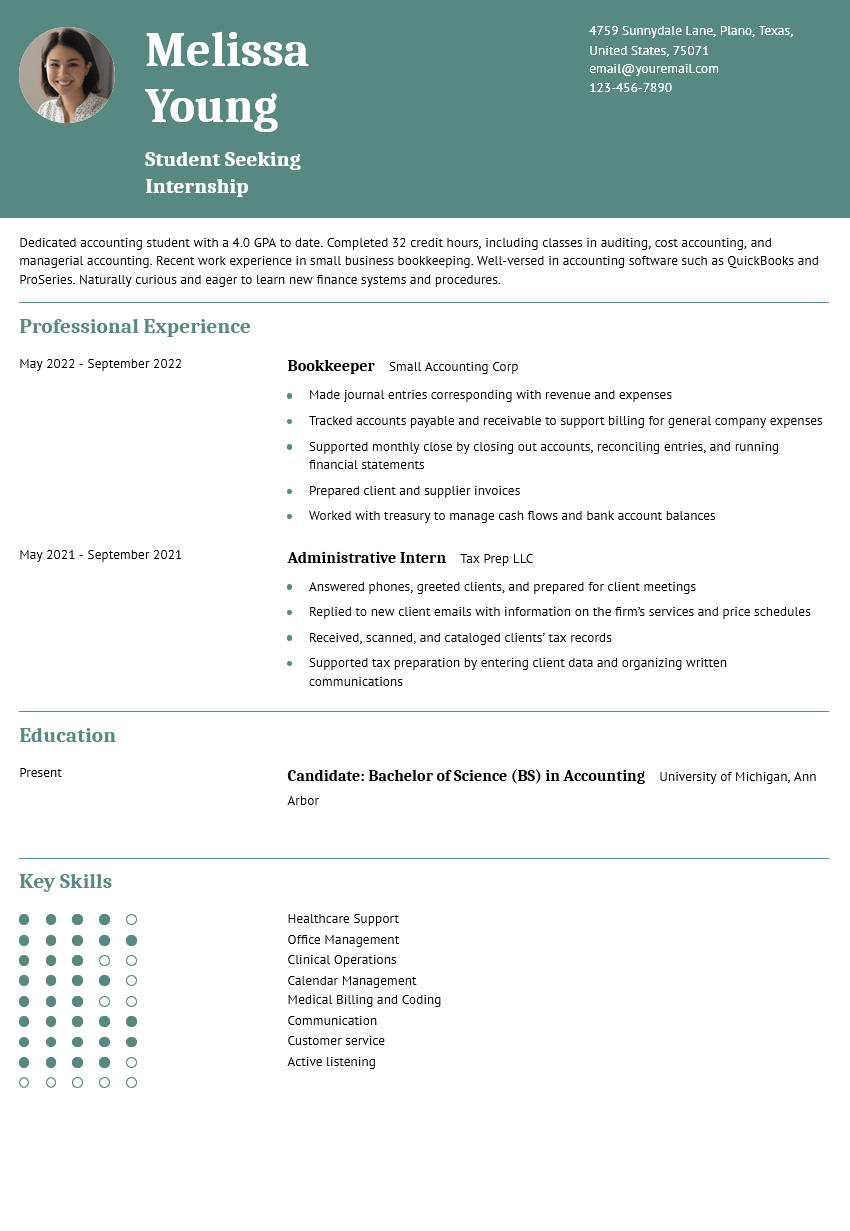
Get hired 33% faster with our feature-packed and easy-to-use resume builder app
ResumeBuilder.com is now part of Bold LLC. For more information visit our Terms of Use and Privacy Policy .
Use our potent creation tools and expert guidance to create the perfect resume for your next job application.
Choose from 25+ applicant tracking systems (ATS)-friendly modern and professional templates.
Select custom fonts and colors on any resume template.
Use our more than 500 resume examples and templates to see what a great resume looks like in your field.
Sail through applicant tracking systems with resume templates that appeal to both machines and humans.
Get help every step of the way as you build your resume with expert tips and suggested phrases.
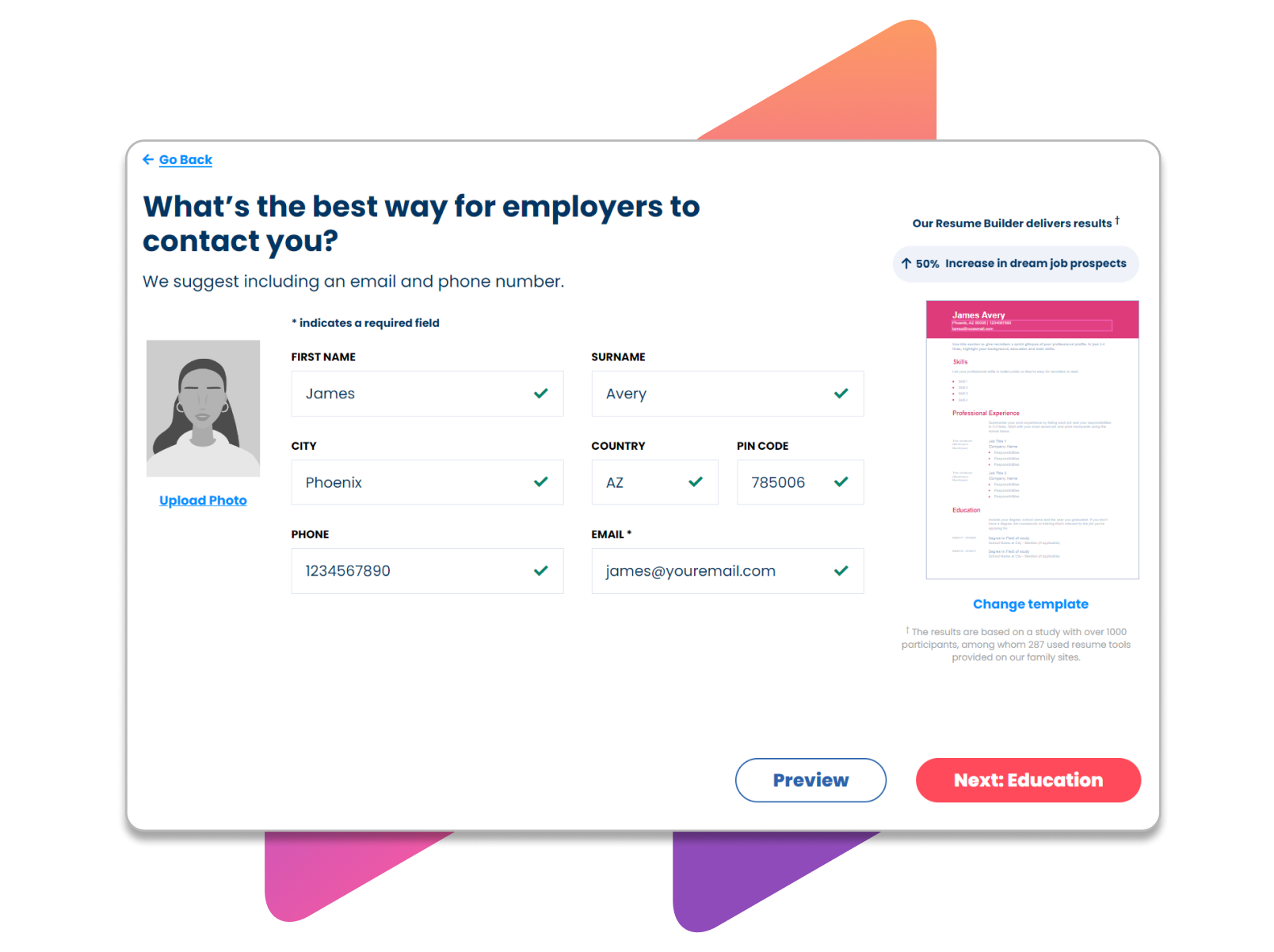
Powerful AI Resume Tool
Find the right words and automate your resume writing process with Resume Builder’s free AI resume writer. Just enter a job title or phrase, and our AI will provide suggestions that show employers you’re the best fit.
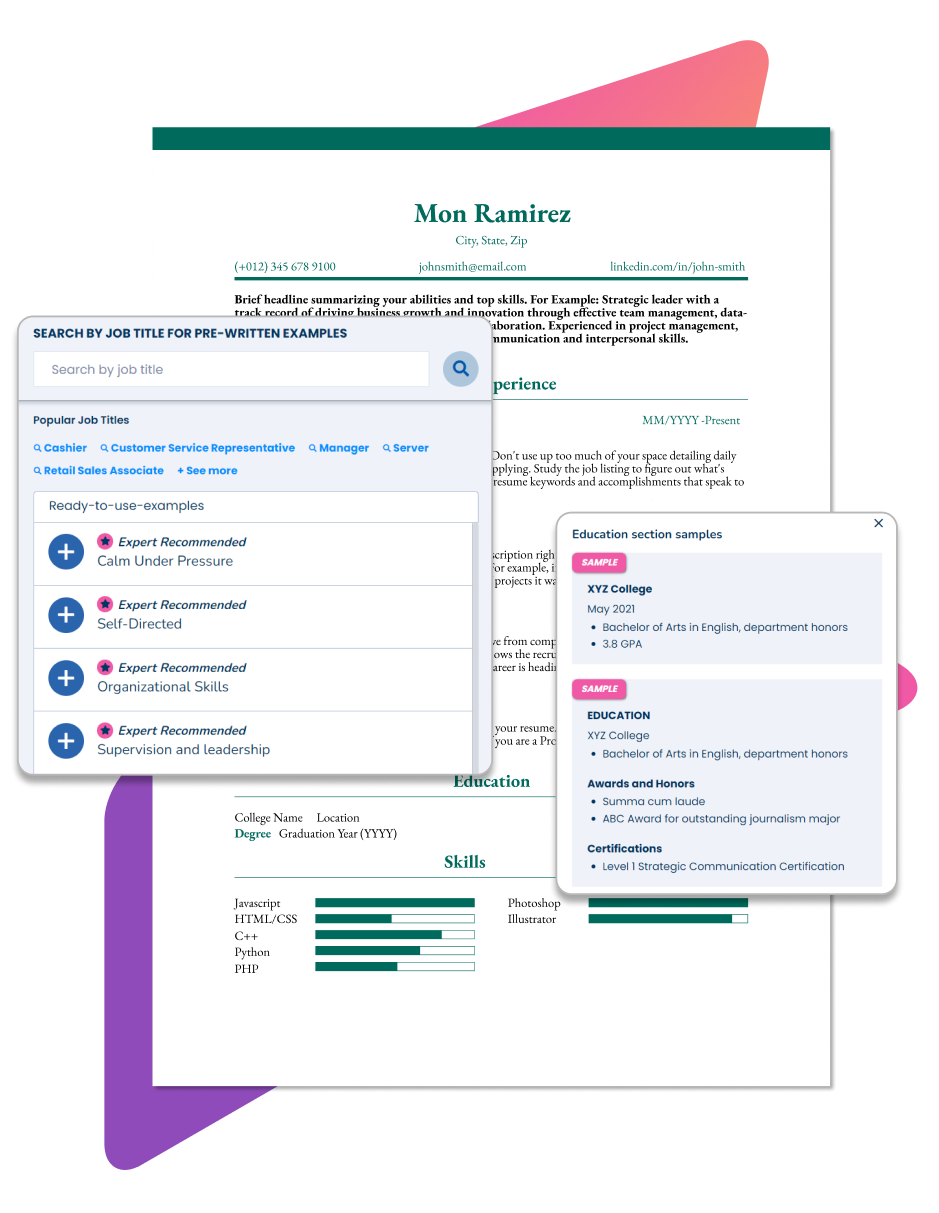
Expert Tips and Suggestions
Use Suggested Phrases to get job-specific phrases from certified resume writers that help you plug in job descriptions, career summaries, and more.
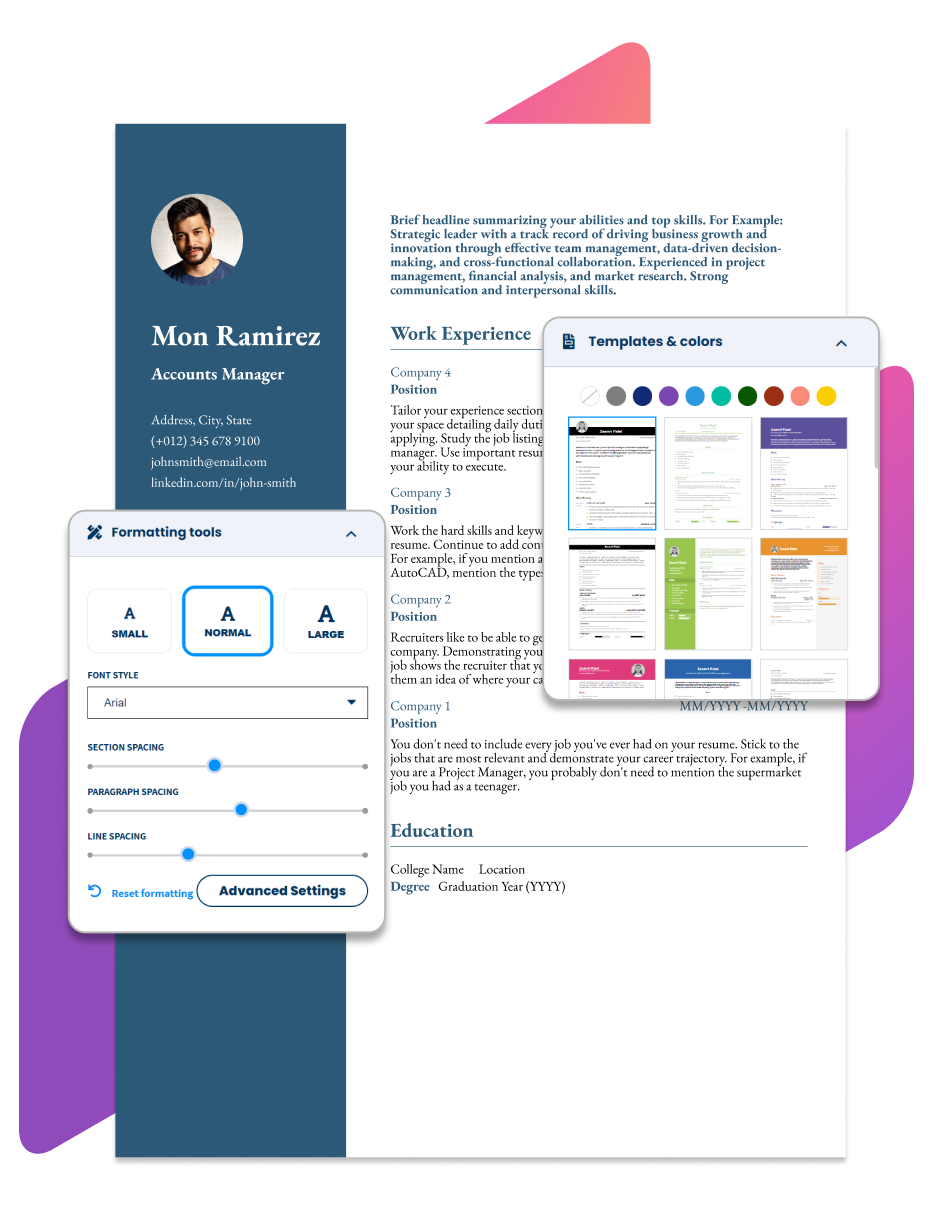
Customize Your Resume
You can change the font styles, colors, and layout of your resume to stand out from the competition.
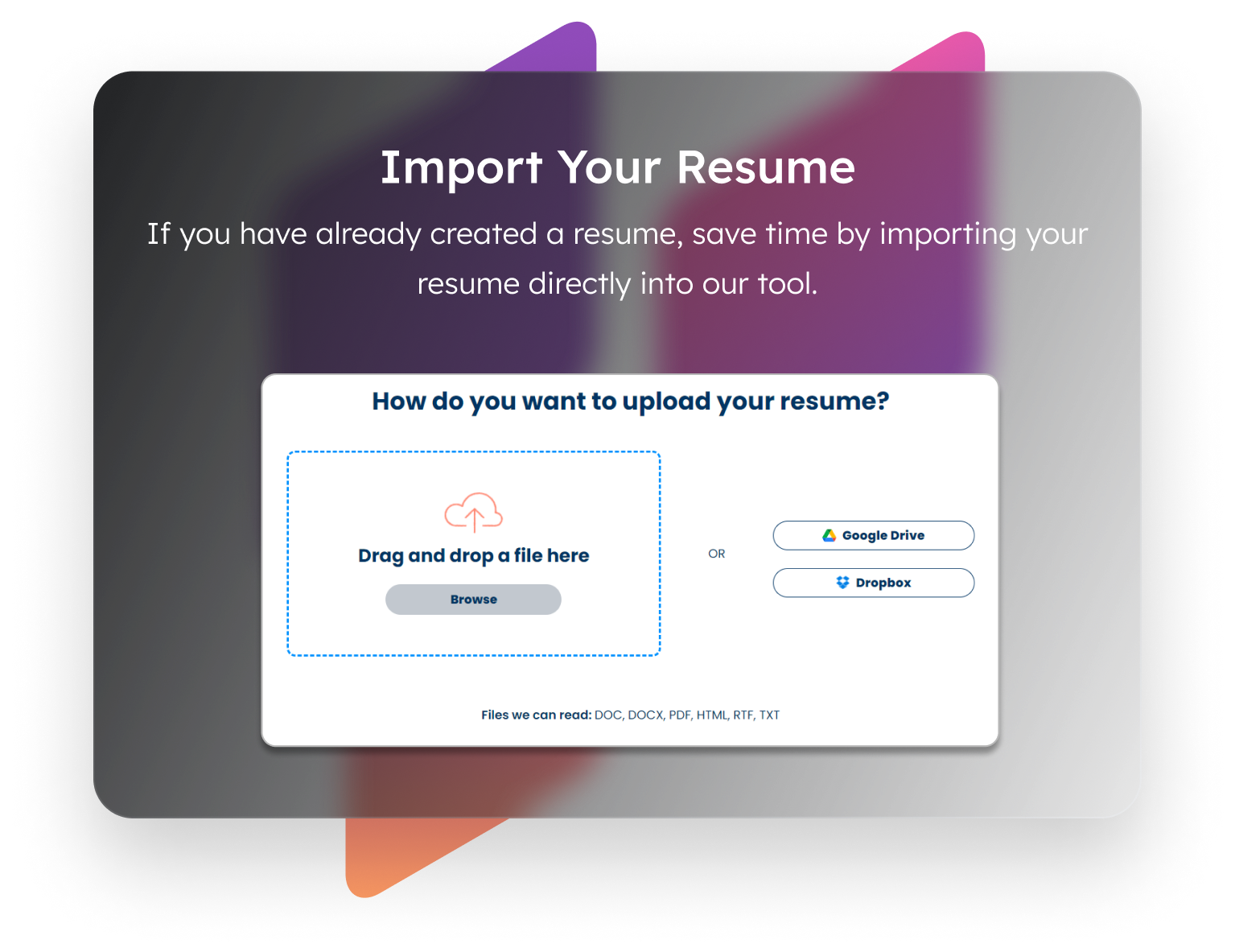
Import Your Resume
Create your resume from scratch, or you can start by uploading your own resume.
Get inspired by expertly crafted resume examples
- Engineering
- High School
- Medical Assistant
- Customer Service
- Information Technology
- New Grad Nursing
- Nursing Student
- Project Manager
- Software Developer
- Sales Associate
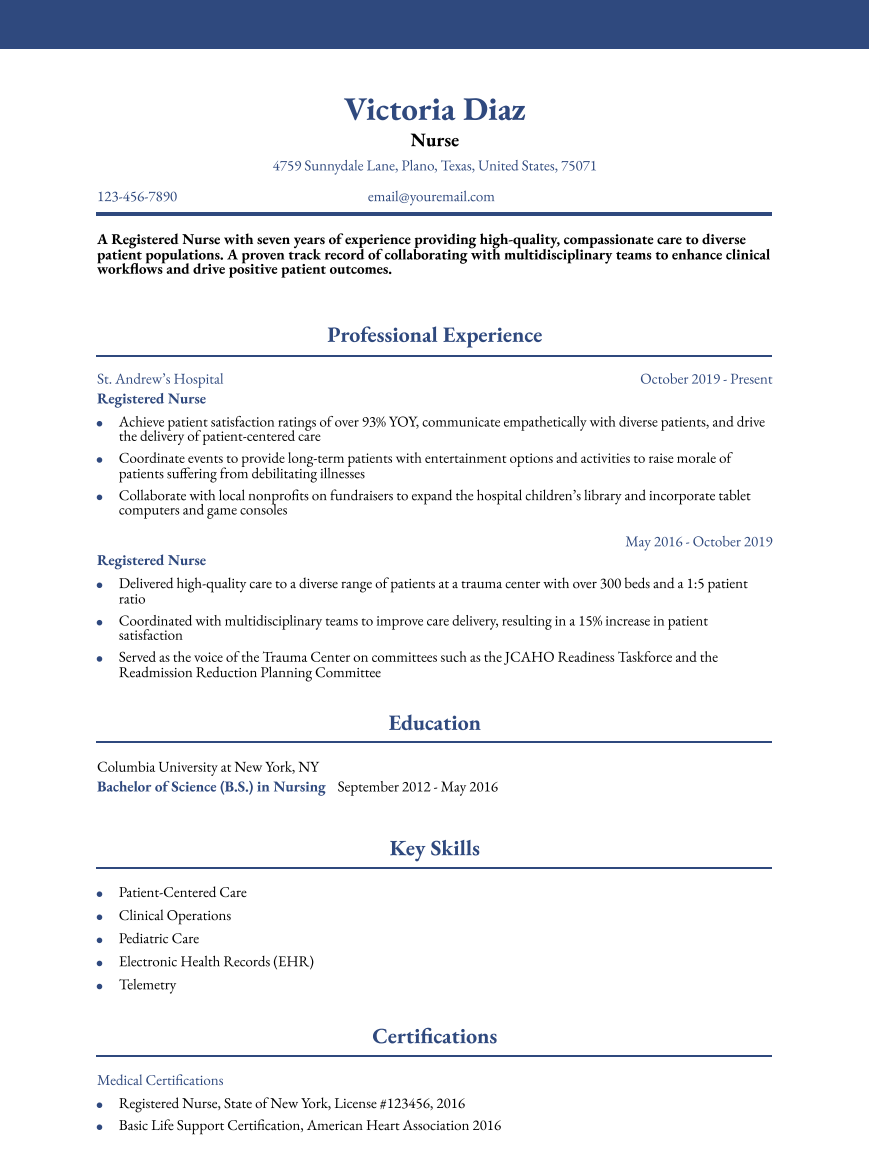
What users say about Resume Builder
Let’s land your dream job together, frequently asked questions about resume builder.
Using the Resume Builder app, you have a 30% higher chance of getting a job, and our users experience a 42% higher response rate from recruiters. You’ll get expert guidance every step of the way, with 25+ professional resume templates and AI-enabled suggestions to write a resume that gets results.
With Resume Builder, you’ll select and customize a template, then create your resume either with step-by-step guidance or by importing your current resume. You’ll add your experience, education, key skills, and more, aided by expert tips, suggested phrases, and an AI writer tool. Then, save your resume by creating a free account . You can download your TXT resume or upgrade to a paid subscription to download your professionally designed PDF resume.
Yes. Tailoring your resume is one of the best ways to get more interviews. Look at the job posting to identify what the employer is seeking. Specifically, find important words or phrases to use in your profile and key skills sections.
Yes. Resume Builder has more than 500 free resume examples and templates . Use these examples to get expert advice on what you should - and shouldn't - include in your resume, such as common key skills and action verbs for your desired job.
Our AI resume builder uses AI writing tools to help you go from a blank page to a first draft and can give you plenty of ideas for more content to include. It can help you turn a prompt like “Spanish” into “Taught Spanish language and culture classes to students of all ages and abilities” in one click. It also helps you add the right keywords so your resume performs well on applicant tracking systems (ATS).
Our AI resume builder follows best practices for resume phrasing, tone, and verb tense, ensuring you sound appropriate and professional. Using this feature gives you a better sense of that language style, so you can more easily add information to your resume later on.
We recommend downloading your resume in both PDF and text format. A professionally designed PDF resume has a visual impact, and its appearance is consistent across computer screens and systems. But you may need a text format resume for some job applications, so it's good to have both available.
With the Resume Builder app, it’s free to build, save, and download your resume in text format. With a paid subscription, you can download your resume as a PDF. Learn more about how to use Resume Builder for free .
Resume Builder offers numerous resume creation solutions for your career needs for only $2.95 during the 14-day trial period. Our application infuses AI-powered technology and writing methodologies from certified resume writers to help you build and customize your resume and cover letter.
Below, you’ll find our pricing options:
|
|
|
| : Unlimited access to all features, download your completed resume as a text-only (TXT) file | Free |
| : Unlimited access to all features, download your completed resume as a Word or PDF file | $2.95 for 14-days, then $23.95 billed every four weeks |
| : Unlimited access to all features, download your completed resume as a Word or PDF file | $7.95 ($95.40 annual billing) |
With Resume Builder’s cover letter app , you’ll select and customize a template, then create your cover letter either with step-by-step guidance or by importing info from a resume document. You’ll add your experience, education, key skills, and more, aided by expert tips, suggested phrases, and an AI writer tool. Then, save your cover letter by creating a free account. You can download your cover letter by upgrading to a paid subscription.
Yes. Tailoring your cover letter and resume is one of the best ways to get more interviews. Look at the job posting to identify what the employer is seeking. Specifically, find important words or phrases to use in your profile and key skills sections. You can get inspiration from Resume Builder's cover letter examples to get expert advice on what you should - and shouldn't - include in your cover letter, such as common key skills and action verbs for your desired job.
We recommend downloading your cover letter in both PDF and text format. A professionally designed PDF cover letter has a visual impact, and its appearance is consistent across computer screens and systems. But you may need a text format cover letter for some job applications, so it's good to have both available.
If you can’t log into your account from the log in page , please try performing one or more of the following:
- If you see an “email does not exist” error message, your email address is not located in our database. Please try using a different email address that might be associated with your account or sign up for an account.
- If you see a “Invalid Email/Password” error message, you may have entered an incorrect password. Please try again or reset your password (see instructions below).
- Clear your browser cache.
- Close all browsers and restart your PC.
- Visit the log-in page using a private or incognito window in your browser.
- Disable your browser extensions, close your browser, and reopen it to the login page.
Please contact us if you continue to have issues logging into your account.
To change your ResumeBuilder.com account password, please do the following steps:
- Go to the Resume Builder app login page .
- Click the Forgot Password? link under the blue Log In button.
- Enter the email address associated with your ResumeBuilder.com account.
- Click Reset Password.
- You will receive an email at the address you provided. Follow the instructions in the email to finish resetting your password.
Please contact us if you continue to have issues resetting your password.
Our customer service representatives are available 24 hours a day. Representatives can help with any technical difficulties, questions about your account, or any other questions you may have. See our contact info to get in touch.
*The names and logos of the companies referred to above are all trademarks of their respective holders. Unless specifically stated otherwise, such references are not intended to imply any affiliation or association with ResumeBuilder.com.

40+ Resume Tips to Help You Land a Job in 2024

When you haven’t updated your resume in a while, it can be hard to know where to start. What experiences and accomplishments are relevant for the jobs you’ve got your eye on? What new resume rules and trends should you be following? And seriously, one page or two ?
Well, search no more: We’ve compiled all the resume tips you need into one place. Read on for advice and tricks that’ll help you craft a winning resume—and land your next job.
Maximize your chances by looking for more open jobs on The Muse »
Basic resume tips
Let's start with the basic do's and don'ts when putting your resume together. Listing your skills is not the only thing that matters—choosing the right format and sections is equally crucial. Here are some tips for writing a resume from scratch:
1. Don’t try to cram every skill and work experience onto your resume
Think of your resume not as a comprehensive list of your career history, but as a marketing document selling you as the perfect person for the role you’re applying to. For each resume you send out, you’ll want to highlight only the accomplishments and skills that are most relevant to the job at hand (even if that means you don’t include all of your experience ).
This is called tailoring your resume and it helps anyone who reads it see exactly why you’re a match for a specific position.
2. But keep a resume outline with a full list of your qualifications
Since you’ll be swapping different information in and out depending on the job you’re applying to, save a resume outline —or maybe our resume worksheet —on your computer with old positions, bullet points tailored for different applications, and special projects that only sometimes make sense to include. Think of this as your brag file. Then, when you’re crafting each resume, it’s just a matter of cutting and pasting relevant information together.
3. Ditch the objective statement
The only time an objective section makes sense is when you’re making a huge career change and need to explain from the get-go why your experience doesn’t match up with the position you’re applying to. In every other case, resume objectives just make you look old-fashioned or out of touch.
Read More: 3 Reasons You Should Ditch That Resume Objective—and 3 Things You Can Do Instead
4. Put the best, most relevant information first
In journalism speak, “above the fold” refers to what you see on the front half of a folded newspaper (or, in the digital age, before you scroll down on a website)—basically it’s your first impression of a document. In resume speak, it means you should make sure your most relevant qualifications are visible on the top third of your resume.
This top section is what the hiring manager is going to see first—and what will serve as a hook for someone to keep on reading. If your most recent position isn’t the most relevant piece of your candidacy, consider leading with a skills section (such as in a combination resume format ) or writing a resume summary .
5. Choose the right resume format for you
There are lots of different ways to organize the information on your resume—like the functional resume or combination resume. But the good old reverse chronological —where your most recent experience is listed first—is usually your best bet. Unless it’s absolutely necessary in your situation, skip the functional or skills-based resume—hiring managers might wonder what you’re hiding.
6. Keep it concise
The two-page resume is a hotly debated topic, but the bottom line is this—you want the information here to be as short as possible, and keeping it to one page forces you to prioritize what really matters. If you truly have enough relevant and important experience, training, and credentials to showcase on more than one page of your resume, then go for two. But if you can tell the same story in less space? Do it.
Read More: 6 Pro Tips for Cutting Your Resume Down to One Page
7. Include relevant links
Can’t figure out how to tell your whole story on one page, or want to be able to include some visual examples of your work? Instead of trying to have your resume cover everything, cover the most important details on that document. Then, include a link to your personal website , your online portfolio , examples of your work, or a relevant, professional social media profile , where you can dive more into what makes you the ideal candidate.
Just avoid hyperlinking over words that are key to understanding your resume, since it can throw off the tools employers use to store and parse resumes.
8. Be aware of the ATS
You may have heard that employers are using computers to “read” your resume and decide who to hire and reject. That’s not exactly true. But most employers do use software called an applicant tracking system—or ATS—to parse resumes and organize them so that recruiters and hiring managers can search for the most relevant applications.
You should assume your resume will pass through an ATS at some point during your job search, so understanding how it works will help make your hunt more efficient. (All of the tips for resume writing in this list keep ATSs in mind as well!)
Read More: Beat the Robots: How to Get Your Resume Past the System and Into Human Hands
Resume formatting tips
Your resume's format matters as much as the content it holds. Aim for a simple and minimalist layout, without overwhelming columns, colors, or graphic elements. Here are some key resume formatting tips to help you stand out:
9. Keep your resume format simple
We’ll talk about getting creative in order to stand out in a minute. But the most basic principle of good resume formatting and design? Keep it simple. Make your resume easy on hiring managers’ eyes by using a reasonably sized default font like Helvetica or Arial and leaving a healthy amount of white space on the page. Your main focus here should be on readability for the hiring manager (and that pesky ATS).
Read more: The Best Resume Font and Size (No More Agonizing!)
10. Stand out with ATS-friendly design elements
Really want your resume to stand out from the sea of Times New Roman? Yes, creative resumes —like infographics, videos, or presentations can set you apart, but you have to make sure they actually get read. If you’re uploading your resume to a job application site or online portal, use ATS-friendly formatting elements like:
- Bold and italic text
- Underlining (in headings or over hyperlinks)
- Different text alignments
- Columns that can be read straight across
11. Avoid design elements that can’t be “read” by computers
On the flip side, it’s best to avoid design elements that ATSs are known to have trouble with such as:
- Logos and icons
- Images and photos
- Graphics, graphs, or other visuals
- Headers and footers
- Less common fonts
- Columns that can only be read from top to bottom
12. Make your contact info prominent
You don’t need to include your address on your resume anymore (really!), but you do need to make sure to include a phone number and professional-sounding email address (but not one affiliated with another job!) as well as other places the hiring manager can find you on the web, like your LinkedIn profile, plus your pronouns if you’d like to.
Read More: Here's Exactly What Should Be Included in Your Resume's Header
13. Design your resume for skimmability
You’ve probably heard before that hiring managers don’t spend a lot of time on each individual resume. So help them get as much information as possible in as little time as possible, by making your resume easy to skim .
Work experience resume tips
Recruiters nowadays want to know more than a simple description of your responsibilities. They're looking for the results and impacts of your work, as well as the connection between your experience and the position you're applying for now.
That said, let's take a look at some resume writing tips for describing your work experience:
14. Keep your work experience recent and relevant
As a rule, you should only show the most recent 10-15 years of your career and only include the experiences that are relevant to the positions you’re applying to. Remember to allocate real estate on your resume according to importance. If there’s a choice between including one more college internship or going into more detail about your current role, always choose the latter (unless the internship was more relevant to the role you’re applying for).
15. Don’t forget your transferable skills and experiences
Don’t panic if you don’t have any professional experience that fits the bill. Focus your resume on your relevant and transferable skills along with any related side or academic projects , and then make sure to pair it with a strong cover letter telling the narrative of why you’re ideal for the job.
Read more: What to Put on Your Resume When You Have No Relevant Work Experience
16. Write strong, achievement-focused bullet points
The bullet points under each job entry are arguably the most important part of your resume. They tell whoever’s reading it what skills you have, how you’ve used them, and how you’ve helped your employers in the past.
So start with a strong action verb , include relevant skills from the job description , and frame your bullets around your achievements—don’t just list your job duties . Tell them how your work benefitted your boss or company so they know what they stand to gain by hiring you.
Here’s a simple formula to follow:
- Compelling verb + job duty + key skills used = tangible result
So you might say: “ Developed an upgrade to the employee database, ensuring the smooth flow of critical operations, which led to a 35% increase in efficiency. ”
17. Curate your bullet points and experiences
No matter how long you’ve been in a job, or how much you’ve accomplished there, you shouldn’t have more than eight bullet points under it—and that’s only for your most recent and relevant job. Jobs further back should generally be limited to four to six bullets.
Read More: How Many Bullet Points Should Each Job on Your Resume Have?
18. Use as many numbers as you can
Use facts, figures, and numbers whenever possible in your bullet points. How many people were impacted by your work? By what percentage did you exceed your goals? Quantifying your accomplishments allows the hiring manager to picture the level of work or responsibility you needed to achieve them.
19. Don’t neglect non-traditional work
There’s no law that says you can only put full-time or paid work on your resume. So, if you’ve volunteered , worked part-time or as a temporary or contract worker , freelanced, or interned? Absolutely list these things as their own “jobs” within your career chronology—as long as they’re relevant to the job you’re applying for. The same goes for career breaks . Yes, really.
Read More: 4 Things You Didn't Know You Could Put on Your Resume
20. Use important keywords from the job description
Scan the job description, see what words are used most often, and make sure you’ve included them in your bullet points. For example, does the job description list “CRM” or “Salesforce”? Make sure your resume matches. Not only is this a self-check that you’re targeting your resume to the job, but it’ll also make it easier to search for your resume in an ATS.
Read More: How to Pick Resume Keywords That'll Get Your Job Application Past the ATS
Resume tips for including your education
Most hiring managers will want to know your education level, even if it's not necessarily relevant to the position you're going for. This section is especially important for those changing careers or applying for entry-level jobs—as your education can be an indicator of the skills you have.
Here's some resume tips and tricks for this section:
21. Put experience first, education later
Unless you’re a recent graduate , put your education after your experience. Chances are, your last couple of jobs are more important and relevant to you getting the job than where you went to college.
22. Also keep it in reverse chronological order
Generally, you should list your educational background with the most recent or advanced degree first, working in reverse chronological order. But if older coursework is more specific to the job, list that first to grab the reviewer’s attention.
23. Remove the dates from your education section once you’re a few years into your career
Unless you’re early in your career, don’t list your graduation dates. The reviewer cares more about whether or not you have the degree than when you earned it. And you don’t want to inadvertently open yourself up to age discrimination , which is an unfortunate reality in some job markets.
24. Highlight honors and achievements, not GPA
If you graduated from college with high honors, absolutely make note of it. Showcase that summa cum laude status, the fact that you were in the honors college at your university, a relevant project you completed, or an award you won. You don’t need to list your GPA —employers don’t care as much about GPA as they do what skills you gained in school.
Read More: How to (and How Not to) List Education on Your Resume

25. Include continuing or online education
Feel free to include continuing education, professional development coursework, or online courses in your education section, especially if your resume feels a little light on relevant experience.
Best resume tips for showing off your skills
You shouldn't wait until you get an interview to showcase your skills—your resume can and should have a specific section for them. You can also leverage other sections of the document to incorporate what's relevant for the position.
Here are our tips for making a resume that effectively highlights your skills:
26. Don’t forget your skills section
Be sure to add a section that lists all the relevant skills you have for a position—especially those mentioned in the job description. Include technical skills like software and project management tools or specific knowledge of how to perform relevant tasks. Just make sure to skip including skills that everyone is expected to have, like using email or Microsoft Word. Doing so will make you seem less technologically savvy.
27. But don’t only put your skills in your skills section
Your skills section is an easy way for anyone reading your resume to confirm that you have required qualifications, but that shouldn’t be the only place that your important skills appear. Any skill that’s vital to you being hired should also be in your bullet points—where you can show how you’ve used it in the past.
28. Divvy up your skills for readability
If you have lots of skills that would help you with a job but aren’t necessarily in the same category—say, foreign language, software, and leadership skills—try breaking up your skills sections. Below your “Skills” section, add a subsection titled “Language Skills” or “Software Skills,” for example. Again, we’re going for skimmability here!
29. Show—don’t tell—your soft skills
Describing soft skills on a resume often starts to sound like a list of meaningless buzzwords. But being a “strong leader” or an “effective communicator” are important characteristics you want to get across. Think about how you can demonstrate these attributes in your bullet points without actually saying them.
Read more: The Non-Boring Way to Show Off Your Soft Skills in Your Job Search
Other resume section tips
Resume sections are not fixed like stone-written texts; they can change according to the job position you're applying for or the requirements listed by the company. Here are some examples of sections you can add—and more tips on writing a resume that stand out:
30. Include relevant certifications and licenses
If you have a certification or license that proves you can do some aspect of the job you’re applying for, include it on your resume. This is especially important if that certification or license is legally required to do the job—for example, in nursing, teaching, or driving jobs.
31. Show some (relevant) personality
Feel free to include an “Interests” section on your resume, but only add those that are relevant to the job. Are you a guitar player with your eye on a music company? Definitely include it. But if you’re considering including your scrapbooking hobby for a software developer job at a healthcare company? Best to leave it out.
32. Beware of interests and activities that could be controversial
Maybe you help raise money for your church on the reg. Or perhaps you’re dedicated to canvassing during political campaigns. Yes, these experiences show a good amount of work ethic or possibly other relevant skills—but they could also open you up to be discriminated against by someone who disagrees with the cause. So weigh your decision to include them carefully.
33. Add awards and achievements—when they’re relevant
Do include awards and accolades you’ve received, even if they’re company-specific awards. Just state what you earned them for, e.g., “Earned Golden Salesperson Award for having the company’s top sales record four quarters in a row.” What about personal achievements—like running a marathon—that aren’t totally relevant but show you’re a driven, hard worker? Consider the best way to include them (and if you should).
Resume tips for navigating employment gaps and other sticky situations
If you're an experienced professional, you might have some tricky information to explain. Job hopping, career gap, and short term jobs are examples of things that can make an applicant feel insecure when drafting resumes.
Is that your situation? Check on these good resume tips to explain sticky situations without jeopardizing your chances to get an interview:
34. Cut the short-term jobs
If you stayed at a (non-temporary) job for only a matter of months, consider eliminating it from your resume to avoid looking like a job hopper. Leaving a particularly short-lived job or two off your resume shouldn’t hurt, as long as you’re honest about your experience if asked in an interview. But if the short-term job is super relevant to this job, consider including it anyway.
35. If you have shorter gaps, be strategic about how you list dates
If you have gaps of a few months in your work history, don’t list the usual start and end dates with months and years for each position. Use years only (2018–2020), or just the number of years or months you worked at each position. Just keep it consistent throughout your resume and don’t lie if asked about gaps during an interview.
Read more: How to Explain the Gap in Your Resume With Ease
36. Explain serial job hopping
If you’ve job-hopped frequently, you can include a succinct reason for leaving next to each position like “company closed,” “layoff due to downsizing,” or “relocated to a new city.” By addressing the gaps, you’ll proactively illustrate the reason for your frequent job movement and make it less of an issue.
37. Explain a long break in jobs
Re-entering the workforce after a long hiatus? This is the perfect opportunity for a summary statement at the top, outlining your best skills and accomplishments. Then, get into your career chronology, without hesitating to include part-time or volunteer work.
38. Be intentional about career gaps
While career gaps are becoming increasingly common, you should still frame them in a way that’s relevant to a future employer, by talking about skills you gained or any professional endeavors you took on. If you didn’t focus on professional development, that’s fine too! But not every employer will appreciate it if you get too cutesy about that section of your resume.
For example, if you took time out of the workforce to raise kids, you might not want to creatively describe this parenting experience on your resume, à la “adeptly managed the growing pile of laundry.” Instead state what you did plainly and include any professional skills you may have grown or activities you may have done.
Read More: Stay-at-Home Parent? How to Kill it on Your Comeback Resume
Tips on resume finishing touches
Writing a good resume alone isn't the only thing that matters. How you save and send it can also determine whether the recruiter will even take a look at it. To wrap things up, here are our resume formatting tips and other suggestions to boost your chances of getting noticed:
39. Ditch “References available upon request”
If a hiring manager is interested in you, they’ll ask you for references—and will assume that you have them. There’s no need to address the obvious (and doing so might even make you look a little out of touch!).
40. Proofread, proofread, proofread
It should go without saying, but fully edit your resume and make sure it’s free and clear of typos. And don’t rely on spell check and grammar check alone—step away for a few hours, then read your resume closely again, and ask family or friends to take a look at it for you.
41. Save it as a PDF or Word document
Unless a job posting specifically requests that you do otherwise, your resume should always be submitted as either a PDF or Word document (.docx not .doc). These are the formats that can be most easily opened and most easily parsed by an ATS.
The choice between the two is up to you (again, unless the company you’re applying to requests one format over the other). If you’re emailing your resume, however, PDFs are a bit more likely to maintain your formatting across different computers and programs.
42. Name your file clearly
Ready to save your resume and send it off? Save it as “Jane Smith Resume” instead of “Resume.” The hiring manager is going to have plenty of “Resumes” on their computer, so make it super easy for them to find what they’re looking for. You can even go a bit further and put the position title in your file name (e.g., “Jane Smith Marketing Analyst Resume).
Read More: The (Simple) Guidelines You Should Follow When Naming Your Resume and Cover Letter Files
43. Keep your resume outline fresh
Carve out some time every quarter or so to pull up your resume outline and make some updates. Have you taken on new responsibilities? Learned new skills? Add them. When your resume is updated on a regular basis, you’re always ready to pounce when opportunity presents itself. And even if you’re not job searching, there are plenty of good reasons to keep this document in tip-top shape.

Online Resume Builder
It takes only 5 seconds to screen your resume. write it well., writing a resume has never been easier. try now for free and create your professional resume within minutes. what are you waiting for.
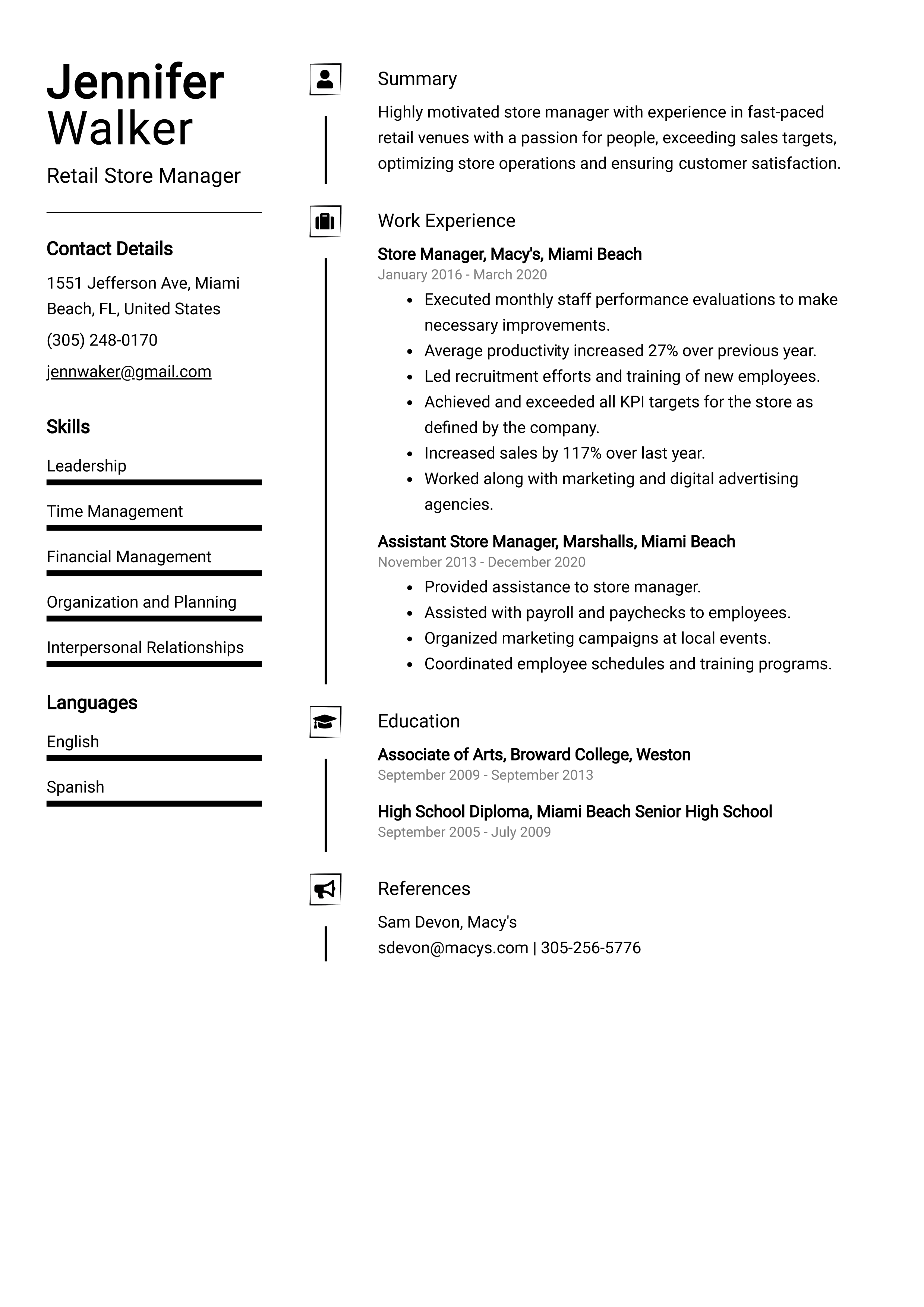
Our professional resumes get people jobs at top companies

Impressive & HR-Approved templates to land your dream job
Choose one of our professional templates. you can easily change colors to any resume format you choose., ready to use templates that will help your resume stand out to recruiters.
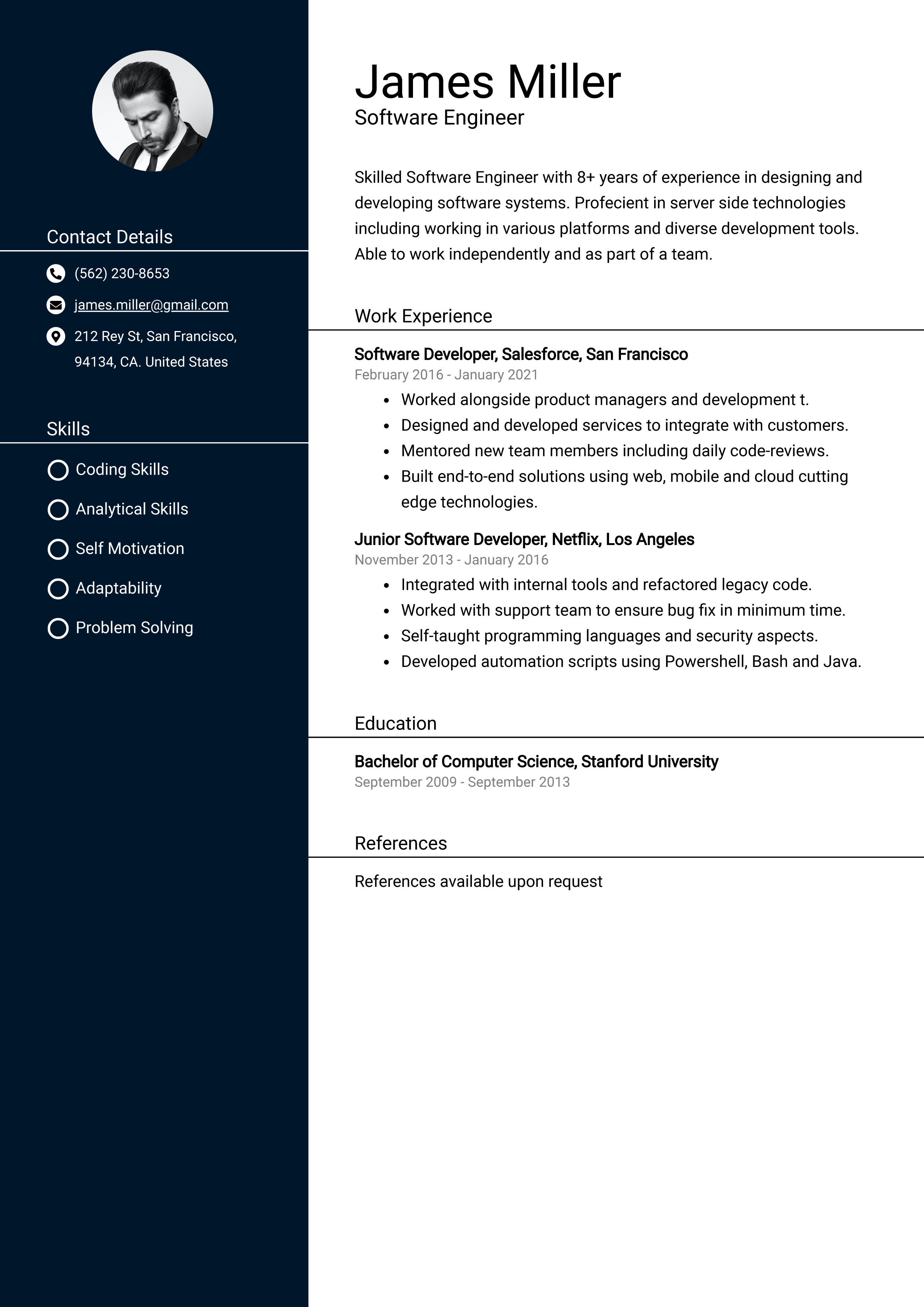
Easy-to-use platform. Create your job winning resume and start your job search!
Try Resumaker's professional resume builder now. Start for free!
10 resume writing tips that will make you stand out.
Here are some helpful tips on how you can ensure that your resume not only highlights your accomplishments and skills, but also captures employers’ attention immediately. 1. Tailor your resume to the job you are applying for. Your resume should showcase your skills and accomplishments as it relates to the role you are applying for. Even if your employment history is not aligned with the role, it is important to find elements that match the requirements of the position you are applying for. This will show employers that you have the potential to grow within the role, and therefore will be more inclined to move forward with your candidacy. 2. A good self-introduction can do wonders. Before you dive into the technical details of your past roles and education, try to add a short introduction of no more than 2-3 sentences. This is your place to tell employers a little about yourself and don’t be afraid to be creative. A few sentences can give employers a chance to get to know you and your potential contribution to their companies. Also, a self-introduction can be useful if you are applying for a role that is outside your current field - use this section as a means to tell employers why this specific position or field interests you. 3. Remember to use a reverse chronological order when listing your jobs, degrees and/or projects (from new to old). Your resume space is limited to one page (unless you have particularly extensive experience) and employers read it from top to bottom when looking for the latest employment experience at the top. 4. Do not use first person in your writing, such as "I made presentations", or “I managed people". This is incorrect and it makes the resume seem like a story. Since this is an official document, it should speak a professional language. For example, you should write that your role in a certain company included: "Preparing presentations", "Managing employees", "Creating collaborations". These should appear as bullet points and neatly organized. 5. Be brief! It is not necessary to list all the roles you have ever held. You want to showcase your most recent experience as it is most relevant to who you are today, and share your less relevant experience in one line at the bottom of your resume. Refrain from including short-term positions that are not relevant to the skills that are required for the position you are interested in (working as a waiter during the studying for a degree, etc.). Also, be careful not to leave "blanks" in your resume, or period during which you did not work. This can make employers wonder about your credibility and reduce your chances of being considered for the role. 6. Use quantitative information to outline your accomplishments. People find it easier to grasp quantitative information, so try to use numbers and percentages when describing your professional experience. Using data will not only specify your experience, but also make it sound more powerful by using concrete examples. For example, instead of saying "budget management", try using "budget management of 10 million dollars per year". Or instead of "employee management", you can say "managing 6 employees". This tip is also useful for entry-level jobs - instead of saying "responsibility for handling customer inquiries", try saying "responsibility for handling about 10,000 customer inquiries a month". 7. Don’t forget to include your soft skills. In your skills section, you should emphasize both your technical and analytical skills, as well your human relations skills. Employers want to know that you will be able to get along with others on the team, so even if you are a security expert with extensive knowledge on the most innovative software, your resume should also emphasize your ability to work in a team environment and communicate well with others. 8. Incorporate keywords into your resume. Use keywords that derive from the job description, from recruiting company’s website, or from descriptions of similar jobs in other companies. For example, if it says that candidates must have knowledge in Microsoft office, add it to your resume - do not let the employer make assumptions about your experience. Be mindful to not overdo it - stay true to yourself and your experience. 9. Pay attention to the smallest details. Impressive design, no spelling errors, a uniform font, bulleted chapter headings, and spaces between paragraphs with reasonable margins. All of these finer details show that you not only invested in your resume, but also you are organized and attentive to detail – which are important qualities to have in any position. 10. Make sure your resume is neat, easy to read and symmetrical. You will have a lot to say about your accomplishments, but the important highlights of your career will be lost if your resume is cluttered and tires the employer. Choose a professional design that highlights your experience and capabilities, and do not be afraid to add a little color so that your resume stands out from other candidates.
Why Resumaker.ai is the best AI resumer builder?
Welcome to the Future of Resume Building: Unveiling Our Unparalleled AI-Powered Resume Builder! In a world where first impressions matter more than ever, crafting a standout resume that captures your unique professional essence is non-negotiable. This is where our AI Resume Builder steps in, ready to revolutionize your job application game and elevate your career journey like never before. What sets our AI Resume Builder apart from the crowded market is not just its cutting-edge technology, but the seamless synergy of innovation and human touch. Here's why we confidently claim to be the best:
- Precision Redefined: Our AI Resume Builder employs state-of-the-art natural language processing (NLP) algorithms to meticulously analyze your input and understand your career objectives. By comprehending nuanced industry jargon and specific job requirements, it tailors your resume to perfection, presenting your skills and experiences in the most relevant and impactful manner.
- Your Story, Your Way: We understand that each individual has a unique professional narrative. Our AI doesn't just generate a generic template – it intuitively adapts to your personal style and preferences. The result? A resume that feels authentically you, resonating with recruiters and employers.
- Time-Saving Brilliance: In today's fast-paced world, time is of the essence. Our AI Resume Builder streamlines the resume creation process, minimizing the hours spent on formatting and content structuring. You provide the information; our AI does the heavy lifting, delivering a polished resume within minutes.
- Adaptability to Trends: The job market evolves, and so should your resume. Our AI Resume Builder keeps pace with the ever-changing recruitment landscape. It is programmed to understand the latest industry trends and incorporate them into your resume, ensuring that you remain ahead of the curve.
- Error-Proof Guarantee: Say goodbye to typos, grammatical slip-ups, and formatting blunders. Our AI Resume Builder is an infallible proofreader, catching even the tiniest mistakes that might escape your notice. This attention to detail showcases your professionalism and commitment to excellence.
- Unrivaled Customization: Whether you're a recent graduate, a mid-career professional, or a seasoned executive, our AI Resume Builder caters to all career stages. It crafts resumes for diverse industries, roles, and skill sets, highlighting your strengths and achievements effectively.
- Confidence Booster: A resume created with our AI Resume Builder not only presents your qualifications eloquently but also instills confidence in you. Knowing that your resume stands out among the competition gives you an edge during interviews and negotiations.
- Privacy and Security: Your personal information is valuable, and we treat it with utmost care. Our platform employs industry-standard security protocols to safeguard your data, ensuring a worry-free experience.
In a world flooded with ordinary resume builders, our AI-powered solution emerges as the beacon of innovation and effectiveness. Trust in a resume-building experience that combines the brilliance of technology with the touch of human finesse. Join countless successful professionals who have unlocked their career potential with our AI Resume Builder. Your dream job awaits – let's build your path to it, together.
What is the difference between Resume and CV?
The distinction between a resume and a CV lies in their length, content, and purpose. In the United States, the terms are often used interchangeably, but in other parts of the world like Europe, they have different meanings.
Resume: - Length: Typically 1-2 pages. - Content: Summarizes your work experience, education, skills, and achievements. It's tailored to the specific job you're applying for, focusing on relevant qualifications. - Purpose: Mainly used for job applications in various industries. Its concise format makes it suitable for quickly showcasing your qualifications to potential employers.
CV (Curriculum Vitae): - Length: Can vary in length, often several pages. - Content: Provides a comprehensive overview of your entire professional history, including all jobs, education, research, publications, presentations, awards, and more. It's more exhaustive and doesn't necessarily get customized for each application. - Purpose: Commonly used in academic and research fields, as well as when applying for positions where a detailed overview of your accomplishments is crucial.
In the US, the distinction between these two terms is prevalent. However, in many other countries, especially in Europe, the term "CV" is used as a synonym for what Americans would call a resume.
It's important to note that conventions can vary, so when applying for jobs or academic opportunities, it's always wise to follow the regional norms and expectations. If you're interested in delving deeper into the subject of Curriculum Vitae, explore our comprehensive guide: "How to write a Resume."
What to include in a Resume?
A resume is a concise document that highlights your qualifications, skills, and experiences, tailored specifically for a job application. It should effectively showcase your suitability for a particular role and capture the attention of potential employers. Here's what you should include in a resume:
- Phone Number
- Email Address
- Optional: LinkedIn Profile (if it's professional and up-to-date)
- A brief statement that summarizes your career goals, skills, and what you bring to the role.
- Tailor this section to match the specific job you're applying for.
- Highlight relevant skills that align with the job description.
- Categorize skills into sections like Technical Skills, Soft Skills, Language Proficiencies, etc.
- List your relevant work experiences in reverse chronological order.
- Include the job title, company name, location, dates of employment, and key responsibilities and achievements.
- Use bullet points to describe your accomplishments in each role.
- Quantify your achievements when possible (e.g., "Increased sales by 20%," "Managed a team of 10").
- List your educational background in reverse chronological order.
- Include the degree(s) earned, institution name, location, dates attended, and any honors or awards.
- Include relevant certifications, workshops, seminars, and training programs.
- This section can demonstrate your commitment to continuous learning and professional development.
- Highlight relevant projects you've worked on, especially if they demonstrate your skills and accomplishments.
- Include the project's name, your role, a brief description, and outcomes.
- Include any relevant awards, honors, or achievements that showcase your capabilities.
- List memberships in industry associations, organizations, or societies that pertain to the role.
- Include relevant volunteer work or extracurricular activities that highlight your character and skills.
- Similar to the resume, you can mention that references are available if required.
- Use a clean and professional format with a readable font.
- Use bullet points for easy scanning.
- Keep the resume to one page for early-career professionals; consider a second page for more experienced candidates.
- Ensure consistent formatting for headings, bullet points, and text alignment.
Tailor your resume for each application by aligning your experiences and skills with the job description. Focus on the most relevant information that will make you stand out as a strong candidate. Proofread carefully to ensure accuracy and clarity. A well-crafted resume will enhance your chances of getting noticed and progressing to the interview stage.
What is a chronological resume, and what order should it be in?
A chronological resume is a type of resume format that focuses on presenting your work history in reverse chronological order. This means that you list your most recent job or experience first and then proceed in reverse order, highlighting your earlier roles. This format is commonly used and is particularly effective if you have a consistent and strong work history. The order of sections in a chronological resume typically follows this structure:
Remember to keep the layout clean, use clear headings, and employ bullet points for easy readability. Tailor your descriptions and achievements to align with the job you're seeking. The chronological format is effective for showcasing a strong work history, but if you have gaps in employment or are changing careers, you might consider other resume formats that better highlight your strengths in those situations.
- Contact Information: Include your name, address, phone number, and email address at the top of the page.
- Summary or Objective Statement: Provide a brief overview of your skills, experiences, and career goals. This section is optional but can be beneficial if tailored to the specific job you're applying for.
- Job Title: Your job title in that role.
- Company: The name of the company you worked for.
- Dates: The duration of your employment (month and year).
- Responsibilities and Achievements: Use bullet points to outline your key responsibilities and accomplishments for each role. Focus on quantifiable achievements and specific contributions.
- Degree: The degree you earned.
- Major: Your field of study.
- Institution: The name of the institution where you studied.
- Graduation Date: The date you graduated or expect to graduate.
- Skills: Highlight relevant skills, both hard and soft, that are pertinent to the job you're applying for. This can include technical skills, languages, software proficiency, and more.
- Optional Sections: Depending on your circumstances, you might include additional sections such as certifications, awards, volunteer work, or relevant projects.
- References: Mention that references are available upon request. You can include this statement, or if requested by the employer, provide references' contact information.
Remember to keep the layout clean, use clear headings, and employ bullet points for easy readability. Tailor your descriptions and achievements to align with the job you're seeking. The chronological format is effective for showcasing a strong work history, but if you have gaps in employment or are changing careers, you might consider other resume formats that better highlight your strengths in those situations.
What is a Cover Letter?
A cover letter is a formal document that accompanies your resume or CV when applying for a job, internship, or other professional opportunities. It's typically sent along with your application materials, either as a physical letter or as part of an email. A cover letter serves as an introduction to your application and provides additional context about your qualifications and motivations.
Key components of a cover letter include:
- Contact Information: Similar to your resume, include your name, address, phone number, and email address at the top of the letter.
- Date: The date on which you're writing the letter.
- Recipient's Information: Address the letter to the hiring manager or relevant person. If you have their name, use it. If not, a generic salutation like "Dear Hiring Manager" can suffice.
- Introduction: Begin with a professional and engaging opening paragraph. Mention the specific job title you're applying for and briefly state how you learned about the position or the company.
- Body Paragraphs: Use one or two paragraphs to highlight your relevant skills, qualifications, and experiences. You can expand upon points from your resume, but avoid restating everything verbatim. Focus on specific examples that demonstrate your suitability for the position and how your skills align with the company's needs.
- Motivation and Fit: Explain why you're interested in the role and the company. Show that you've done your research and discuss how your goals and values align with the company's mission and culture.
- Closing Paragraph: Express your enthusiasm for the opportunity and invite the reader to review your resume or CV for more details. Indicate your willingness to discuss your application further and provide your contact information.
- Closing Salutation: Use a professional closing, such as "Sincerely" or "Best regards."
- Signature: Sign your name above your typed name.
A well-crafted cover letter allows you to showcase your communication skills, demonstrate your genuine interest in the position, and provide insights that may not be fully covered in your resume. It's an opportunity to make a personalized connection with the employer and stand out from other applicants. Customize each cover letter for the specific job you're applying for, addressing the company's needs and showcasing how you can contribute to their success.
- AI Resume Builder
Powered by ChatGPT, Enhancv is the easiest way to create a tailored resume containing all the right keywords, improve your writing & highlight your strengths.
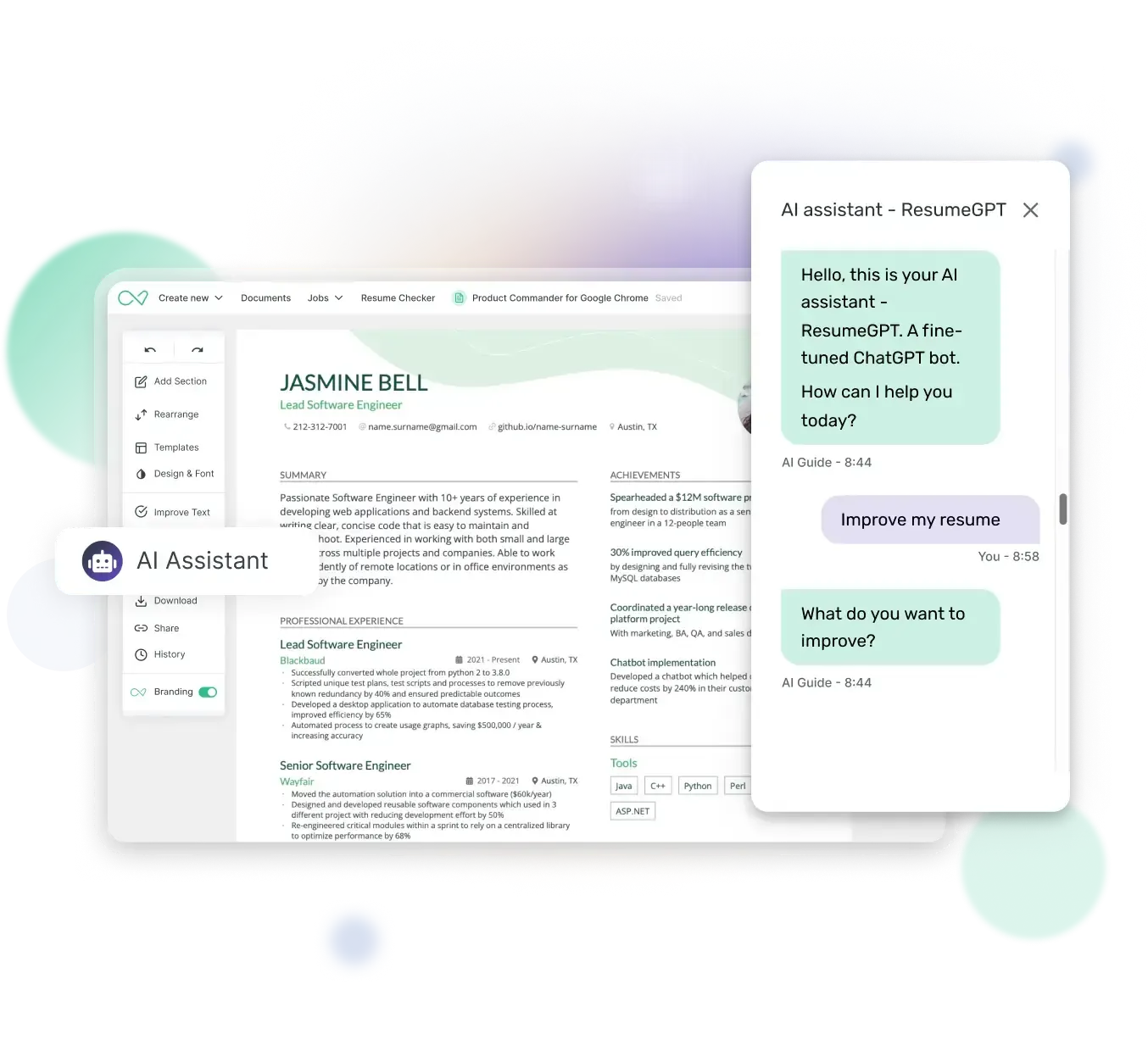
3,908 happy customers shared their experience.
Our resumes get people hired at top companies
AI resume writer, powered by ChatGPT
Nail the keywords, beat the ats.
Use them to identify the high-impact keywords that must be on your resume for each job application.
Improve your writing
Besides the bread & butter spelling & grammar checks, the Enhancv AI assistant helps you re-write your bullets to show impact and focus on your achievements.
AI-Tailored resume summary
Win the recruiter's attention with an AI-tailored resume summary based on the job ad, and a title optimized for keywords in the job.
Highlight your strengths
Stand out from other applicants with a dedicated section to showcase your competitive advantages. Applicants often stumble in writing this section, so our fine-tuned ChatGPT Assistant generates amazing suggestions for you.
Beautiful ATS-friendly templates made with AI

A feature-packed resume builder

Create the perfect cover letter
Use the AI assistant to quickly create the perfect cover letter for each job application, based on your experience.
Start with your old resume or LinkedIn profile
Don’t have the time to start from scratch? Just upload your old resume, or add a link to your LinkedIn profile, and our resume builder will extract all the standard sections.
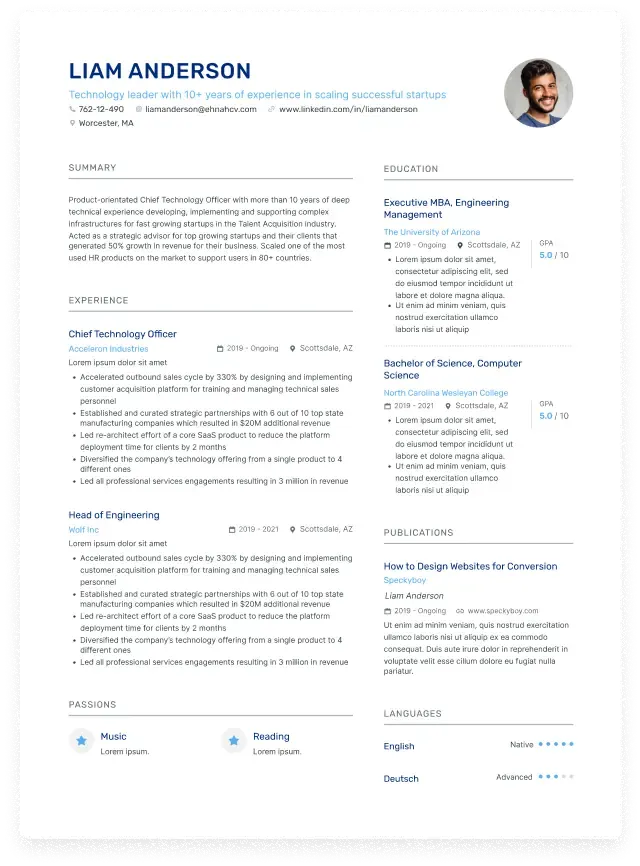
AI resume builder FAQs
What is an ai resume builder.
An AI resume builder is a tool that uses artificial intelligence to assist users in creating their resumes. These tools often have features like customized templates, content suggestions, optimization for Applicant Tracking Systems (ATS), custom tailoring, feedback, and revision options.
What features does Enhancv’s AI resume builder offer?
Enhancv offers a range of AI features to help you create your resume with ease:
- Templates and customization: AI resume builders typically offer a variety of templates that users can choose from. These templates are designed to be both visually appealing and to meet the standards expected in different industries.
- ChatGPT-powered resume content writing and suggestions: Enhancv suggests content based on your input. For example, after entering your job history, you will receive suggestions for expanding upon your professional accomplishments or skills that align with your experience.
- Optimization for Applicant Tracking Systems (ATS): These systems are used by employers to screen resumes before they are seen by a human. Our builder suggests keywords and phrases that are likely to be favorable in these systems based on your job title.
- Feedback and revision suggestions: we’ve got a resume checker that provides feedback on the overall quality of the resume, including suggestions for improving layout, grammar, and wording.
How do I use ChatGPT on my resume?
You can use ChatGPT on your resume for a range of activities, related to resume building, including:
- Rewriting or writing from scratch difficult-to-write resume sections, such as your resume summary and job descriptions.
- Making your resume bullet points more action and performance-oriented.
- Suggesting skills and other keywords to include in your resume based on a job title.
- Suggesting extra sections that can help you stand out from the crowd.
- Using your resume as a starting point for an interview preparation mockup.
- Using your resume as a base for writing your cover letter.
Can recruiters tell if my resume was written by ChatGPT?
As long as your application is customized with your job history and accomplishments, it’s unlikely that recruiters can tell if you used ChatGPT. ChatGPT can only help improve your resume writing, but lying on a resume is unacceptable.
Are resumes scanned by AI?
Resumes in some companies are scanned by an Applicant Tracking System (ATS) which may or may not have AI features. These systems parse resumes and match them with job descriptions. Enhancv’s resume templates are tested for ATS compatibility, though a 100% parsing rate is not guaranteed due to varying ATS models because the content of the resume is more important for ATS-friendliness than the template itself.
Enhancv Executive has changed my life: One week & four interviews later, I will be making 150% more doing the job I chose.
Your resume is an extension of yourself – make one that’s truly you.
- Create Resume
- Terms of Service
- Privacy Policy
- Cookie Preferences
- Resume Examples
- Resume Templates
- Resume Summary Generator
- Resume Formats
- Resume Checker
- Resume Skills
- How to Write a Resume
- Modern Resume Templates
- Simple Resume Templates
- Cover Letter Builder
- Cover Letter Examples
- Cover Letter Templates
- Cover Letter Formats
- How to Write a Cover Letter
- Resume Guides
- Cover Letter Guides
- Job Interview Guides
- Job Interview Questions
- Career Resources
- Meet our customers
- Career resources
- English (UK)
- French (FR)
- German (DE)
- Spanish (ES)
- Swedish (SE)
© 2024 . All rights reserved.
Made with love by people who care.

Search form
Make a Gift
Department of Economics
- Undergraduate
18 Résumé Writing Tips to Help You Stand Out
By Allison Pohle
Updated May 11, 2021 2:15 pm ET
- A résumé isn’t just a list of every job you’ve ever had. It should demonstrate your accomplishments.
- Mirror language used in the job posting so your résumé isn’t discarded by an applicant tracking system.
- Use a clean and simple format.
Companies increasingly rely on software to sort through applicants, which is why it is essential to tailor your résumé to ensure it makes the cut. Applicant tracking systems sort, scan and rank applicants by looking for keywords in applications. Although these programs can save time and money for employers, about 60% said such tools cause them to miss some qualified candidates, according to a 2016 survey of 1,200 job seekers and managers by CareerArc, a human-resources technology company, and Future Workplace, a research firm. Here’s how to make your résumé stand out to robots and humans alike.
1. Highlight your achievements in your résumé.
A common mistake job seekers make is believing a résumé is a recap of your career, when in reality, it should convey what you have accomplished, says Christy Noel, a career expert and author of “Your Personal Career Coach.”
“I always say, spend less of your real estate describing your job, and more time describing your results,” says Ms. Noel.
2. Customize your résumé.
Read over the job posting, and think about the work experience you have had that is most directly relevant to the position you are pursuing. You can leave out some past jobs and internships if the experience you had wasn’t related. Whatever you do: Don’t submit a generic résumé to dozens of postings. “Even if you have the best experience, if your résumé isn’t speaking directly to the position in which you are applying, there is a strong chance you’ll never even get an interview,” says Demisha Jennings, a certified professional résumé writer and founder and owner of She Assists LLC.
The same applies to your cover letter. It is your chance to provide more detail on how your experience will help you succeed in the job. Read our cover letter guide for how to write one that makes you stand out.
3. Decide how to format your résumé.
Most of the time, a chronological résumé will work well for communicating your past experience. But, in some cases, a functional or hybrid résumé might be more appropriate. Read more about résumé formats here.
4. Make your contact information easy to find.
Include your name, phone number, email address, city and state. It may also be appropriate to include the URL to your LinkedIn profile. You want it to be easy for hiring managers to reach out.
In addition to making it easy to connect with you, it is important to your job search that you grow your network. Read our networking guide for tips on how to do so.
5. Consider adding a summary.
Many résumé templates leave space for an objective statement, outlining career goals, but that approach is outdated, says Ms. Jennings. Instead, consider a carefully worded summary. The summary is often the first place a hiring manager will look, and gives you an opportunity to introduce your skills high up on the page. You can also work in relevant keywords from the job description. “Recruiters are looking for what you can bring to the table and what you’ve done, rather than you saying, ‘I’m seeking a position,’” Ms. Jennings says.
6. Great résumés should stand out to skim readers.
Most recruiters spend just a few seconds skimming through a résumé—with an average in one study of 7.4 seconds.
To have the best chance of making an impression, ensure your job titles, company names and dates of employment are easy to read. The sections of your résumé should be adequately spaced, too, says Dana Leavy-Detrick, founder and director of Brooklyn Resume Studio.
For additional ways to make a good impression on recruiters and headhunters, read our guide on how to work with headhunters .
7. Make your résumé robot-friendly.
Structure your résumé to meet the requirements of an applicant tracking system to give yourself the best chance of having it reach an actual human. Ms. Leavy-Detrick suggests the following:
- Optimize keywords. Use the same words and language that are in the job description. For example, three different companies might describe the same role as “programmer,” “developer” or “software engineer.”
- Use a straightforward format. Avoid tables and text-based graphics, which might not get picked up by a scan of the résumé. Sans-serif fonts such as Arial or Helvetica are also best to ensure readability.
- Think about order. When formatting each line item of work experience, list the company name first, followed by the job location (city, state), your job title, and your start and end dates. Some résumés can get lost if the dates are listed before the job title.
8. Prioritize relevant keywords.
Tailoring your skills to include language from the job posting is an important way to let both the applicant tracking system and, eventually, a hiring manager, see how your prior qualifications tie into the job requirements. But just because you have a résumé full of keywords doesn’t mean you’ll automatically get an interview. “The ATS isn’t there to help the job seeker, it is there to help the employer review your skills against their most important qualifications,” says Ashley Watkins, a career coach and résumé writer with Write Step Résumés LLC.
9. Craft compelling and concise bullet points.
The goal of a résumé is to list your accomplishments, rather than every duty you performed in the role. Résumé-writing experts recommend including no more than five bullet points per prior job listed.
- Don’t focus on tasks. Many job seekers describe what they did every day, such as answering phones or creating marketing materials, Ms. Watkins says. “Simply copying and pasting the job description doesn’t account for the things you did great, that you did above and beyond your peers,” she says.
- Instead, explain what those tasks achieved. Emphasize your results. Ms. Watkins suggests asking yourself “Did I save [the employer] money? Did I save time? Did I improve a process? Did I build a relationship?” These will help you format your bullet points.
- Use metrics. Say what you achieved, then contextualize it—with figures if possible. You might not be able to put a monetary value on every accomplishment, but you can frame it by sharing details like the time it took or how many people were involved. “If you raised sales 50% in two months, that means a whole lot more than ‘I’m in charge of sales,’” Ms. Watkins says.
- Don’t omit accomplishments that aren’t quantifiable. Not every achievement will have metrics to show success. If there are figures, you might not always have access to them. But that shouldn’t stop you from including them, says Ms. Leavy-Detrick. Perhaps you had a positive impact on the culture of an organization, or improved a struggling relationship with a client. These efforts could help to demonstrate your soft skills.
10. Focus on transferable skills if you lack experience.
If you are applying for a job in a new field or you are an entry-level applicant and don’t have much direct experience, don’t worry. Highlight transferable skills you have developed in the past that will serve you well in the position, says Ms. Leavy-Detrick. For example, you could play up leadership skills you developed participating in an extracurricular activity or time-management skills you learned in a prior job.
11. Go beyond your work history, and include all relevant experience.
If you are new to the workforce, or are job-hunting after being laid off, you could also include related experience that was outside of a traditional full-time job, says Ms. Watkins. For example, you can highlight volunteer work, consulting projects or educational training, all as part of making the case for your unique value, she says.
12. Don’t worry too much about gaps in your résumé.
The Covid-19 pandemic economy resulted in many people being laid off or furloughed. Ms. Watkins says the 2020 job market reminds her of 2008, when she worked as a recruiter. The expectation at that time, she says, was that candidates would have gaps on their résumés or list more short-term positions. While it isn’t necessary to directly address the gaps in your résumé, you should be prepared to talk about them in an interview . “The focus should not be centered on the fact that you were furloughed or laid off, it should be focused on you and your skills and what you do that impacts the company’s bottom line in a positive way,” Ms. Watkins says.
While it is common to list the months and years you started and ended positions in the job history section, you could just use years. This will draw less attention to a six- or eight-month gap, says Ms. Leavy-Detrick.
13. Highlight relevant skills.
It is common to add a skills section to your résumé , outlining expertise relevant to the position. You can include languages you speak, technical skills or courses you have done. If you lack experience, you can also complete some trainings, which you can find on LinkedIn and elsewhere, related to the job you are applying for and add the courses in this section, says Ms. Jennings.
14. Prioritize work experience over education.
The professional experience you have had is often more relevant to the position than your education history, which is why the work experience should be listed first. In the “Education” section, you should list where you attended college, if applicable, or the highest level of education you have attained. If you graduated with honors, you can flag that, but it isn’t necessary to list your GPA.
15. If you are early on in your career, a key résumé tip is to limit it to one page.
If you are early on in your career, you should limit your résumé to one page. It is OK to start spilling onto a second page after you have eight to 10 years of experience, says Ms. Leavy-Detrick.
16. Add some color for a stylish résumé that sets you apart.
Your résumé should look clean and professional and you should keep applicant tracking systems in mind when formatting the document. But, if it is appropriate, you can add subtle accents of color in the section headings or in bars that separate sections as a way to differentiate your résumé. Ms. Leavy-Detrick doesn’t overstress the need for good design with her clients. “But it can definitely help,” she says. “When I say design, I don’t mean crazy graphic design. I mean having a polished application,” she says. “Think of it the same way you would coming dressed to an interview, it is part of your presentation, and so many people overlook this on the résumé.”
It may be appropriate to incorporate a more creative and graphic-based layout depending on the field in which you work and where you are applying. If you are applying for a position in a creative field, and you are emailing your résumé directly to a hiring manager, then it can be appropriate to use more designs, says Ms. Jennings. But if you are applying to a large company that uses an applicant tracking system or job portal, she says it is best to avoid using graphics unless you are working with a résumé writer who can help you get your resume through the system.
17. Proofread and double-check the formatting.
You may be eager to send your résumé or submit your application, but you should take the time to first check for typos and grammatical errors. You could also have a friend or family member look over it. When you are checking for errors, be sure to double-check the formatting. Sometimes the spacing can get thrown off when you save the file, so check how it looks as a saved document and, if you can, save it as a PDF before sending.
18. Make sure the saved file name includes your name.
Make less work for the hiring manager by including your full name in the file name of the résumé document.
What to read next
- How to Prepare for a Job Interview
- What Questions to Ask During a Job Interview
- Common Job Interview Questions and How to Answer Them
- How to Dress for a Job Interview
- How to Write a Thank-You Email After a Job Interview
- How to Negotiate and Counter a Job Offer
- How to Negotiate Salary for a New Job: The Do’s and Don’ts
- Severance Pay: What It Is and Why You Should Negotiate a Package Before Accepting a Job
Corrections & Amplifications Ashley Watkins is a résumé writer with Write Step Résumés LLC. An earlier version of this article incorrectly said Write Steps LLC. (Corrected on Nov. 20)
Copyright ©2024 Dow Jones & Company, Inc. All Rights Reserved. 87990cbe856818d5eddac44c7b1cdeb8
Appeared in the November 23, 2020, print edition as '11 Résumé Tips to Help You Get Noticed
Resume Templates
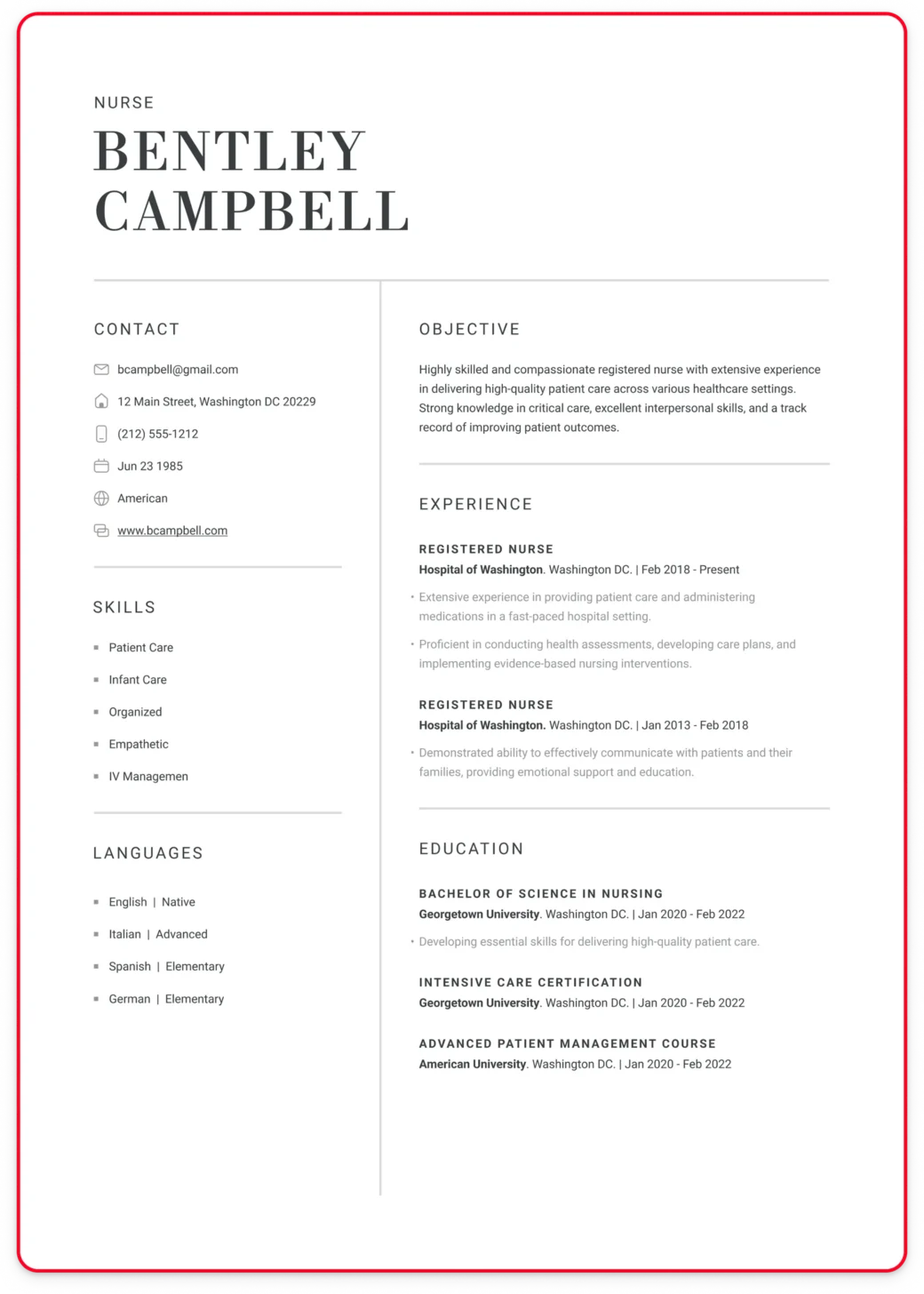
Create and edit your resume online
Generate compelling resumes with our user-friendly tool and secure employment quickly.
Resume examples for 217 jobs
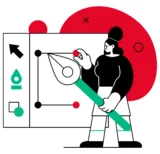
Writing the perfect resume with our help just got easier. Check our resume guides for the job you desire.
Most Popular Resume Examples
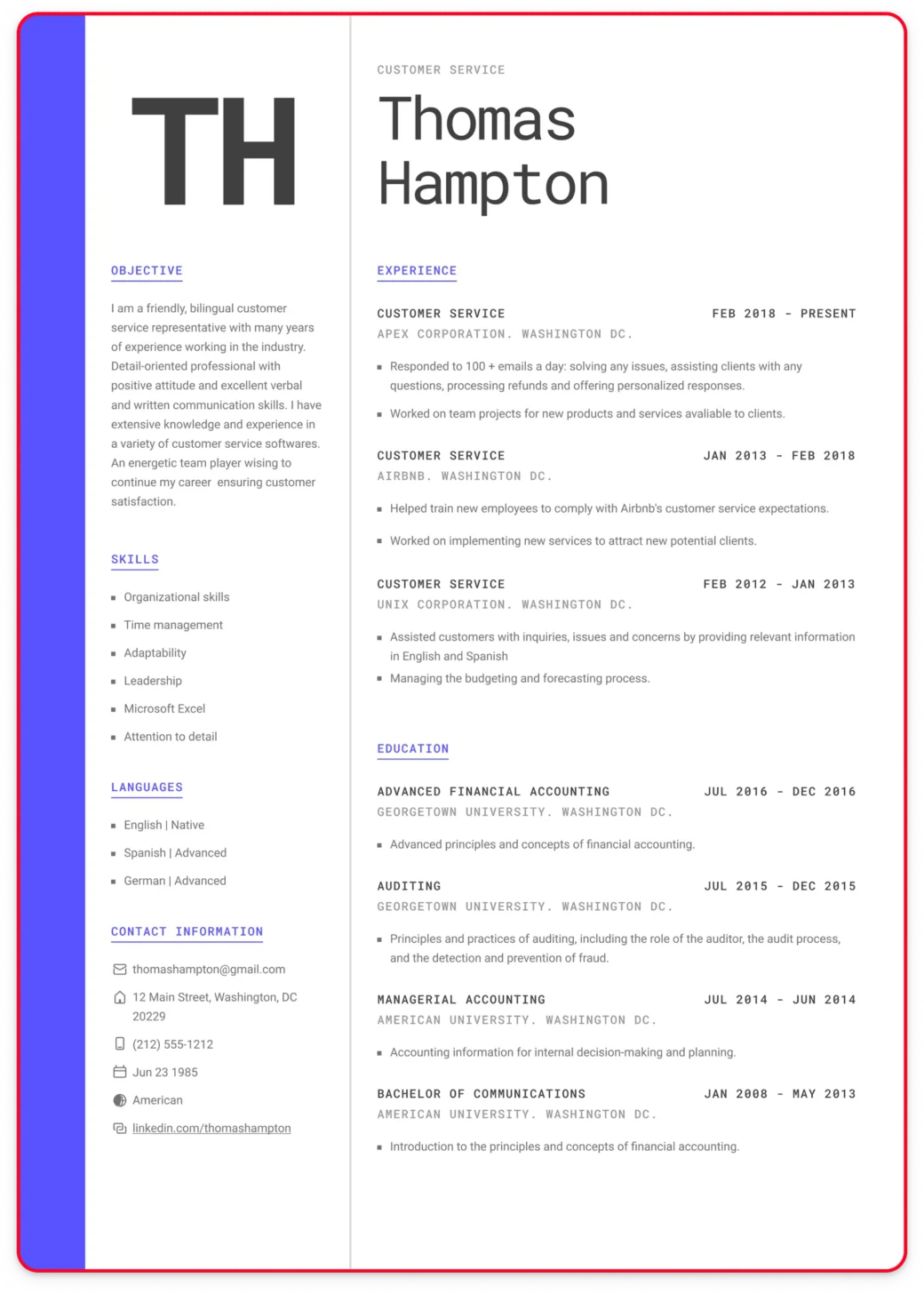
Featured articles
- Free Online Certifications to Add to Your Resume
- Make Shadowing Hours a Part of Your Resume
- How to Decline a Job Offer but Keep the Door Open
Latests articles
- Top People Skills to Include in Your Resume (With Examples)
- The Definitive Guide to Resume Review With AI
- How To Write a Resume for Skills-Based Hiring
- How to Show Your Achievements on a Resume: STAR & CAR Methods
- Improve Your LinkedIn Profile Using ChatGPT
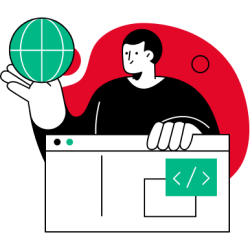
Dive Into Expert Guides to Enhance your Resume
Make use of expert tips & tricks to to help you build the perfect resume
Everything can be completed in just a few minutes and a handful of clicks. Choose a resume template, fill it out and download it, for free !
Our customers have been hired by:

Resume Templates that will get you hired in 2024!

European 2023
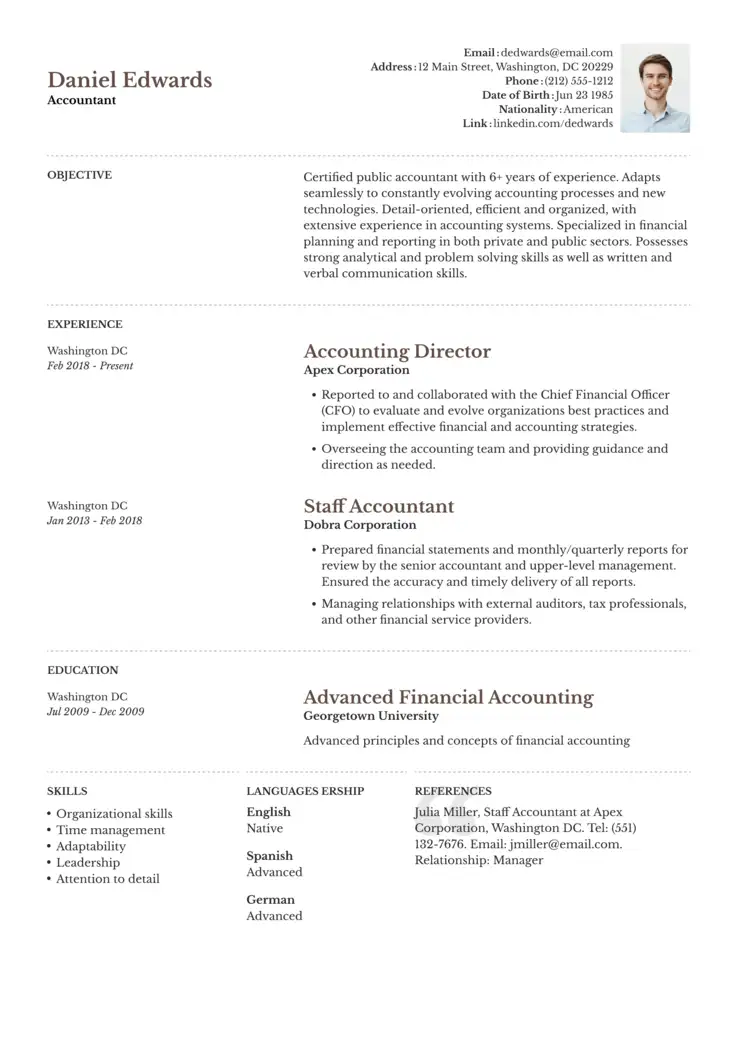
San Francisco
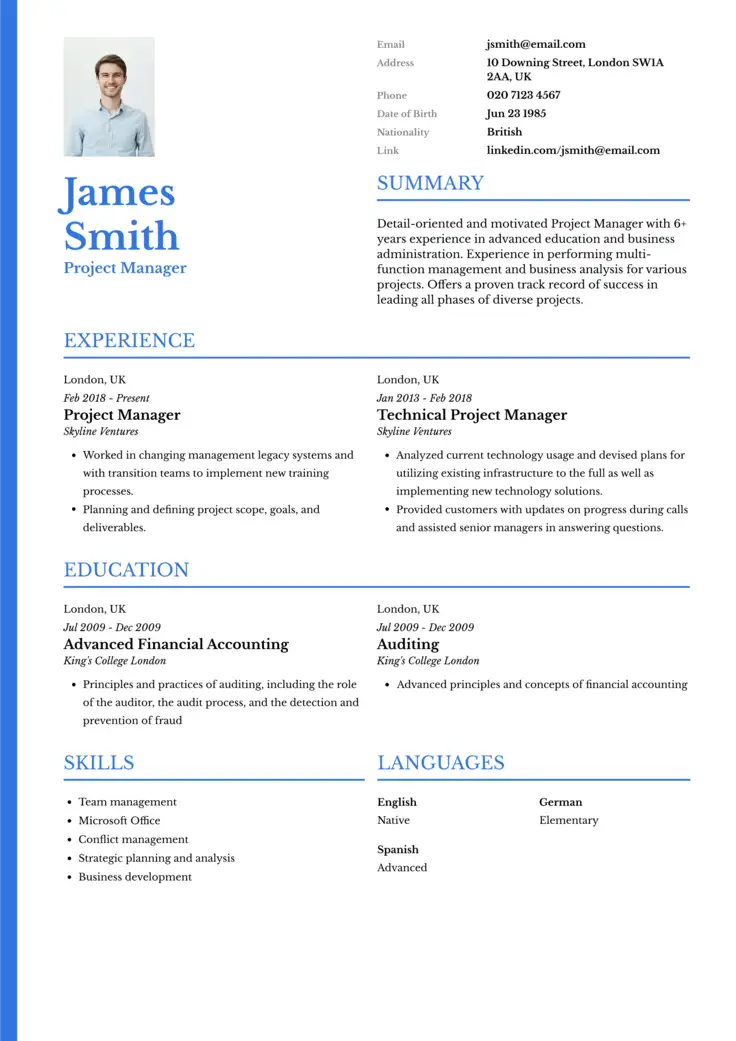
Johannesburg
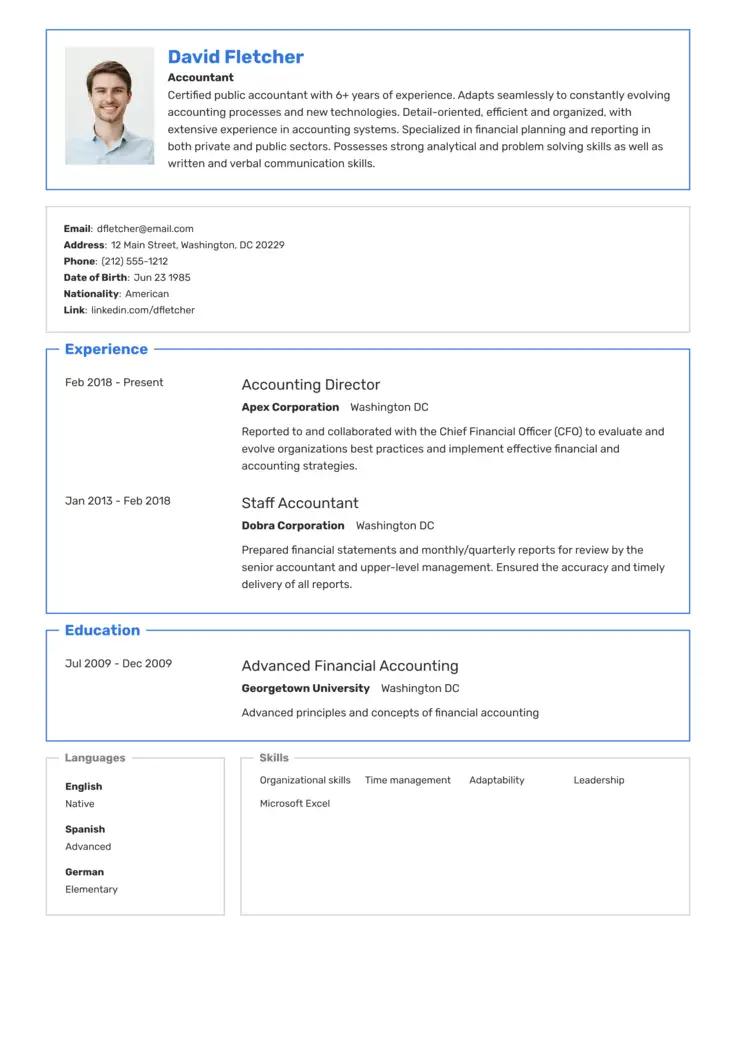
Online Resume Templates That Get Grads Jobs
Entering the job market for the first time is challenging which is why ResumeGiants is designed to help you through the process. Whether you’re targeting an internship, or your first “real job” after graduation, we’re here to offer all the tools and support you need to tackle creating your very first resume template
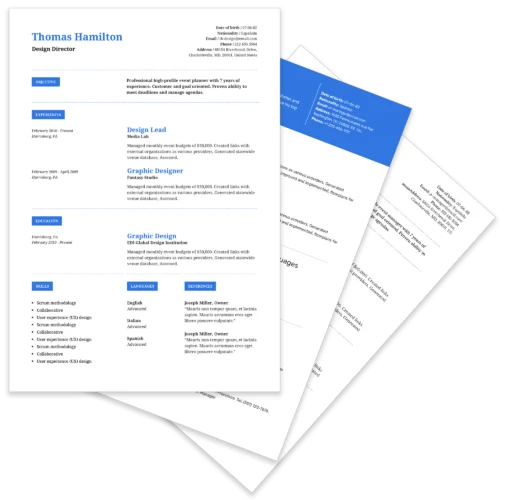
Designs That Resonate with Recruiters
A well-organized and stylish resume template helps grads stand out in the job market and get noticed faster by recruiters. With ResumeGiants you have access to the best layouts and design options that not only look professional but are stylish and eye-catching too.
Easy to Create, Edit, and Download
Creating a resume template for the first time can seem overwhelming at first, but you don’t have to worry. With our resume builder and editor, you’ll see how easy it is to put together your professional profile. Take advantage of step-by-step guidance, customizable templates, and useful tips along the way.
Speed Up the Resume Creation Process
With the help of ResumeGiants, you can cut down on the time spent planning, designing, and writing your resume and spend more time tailoring your file for specific employers. After all, the more time you have, the more jobs you can target.
Create Templates That Are Proven to Work!
The templates we use here at ResumeGiants get results. We know, we’ve tested them! Using resume templates that are proven to work will help you get the confidence you need and, more importantly, the success required to move your career search forward.
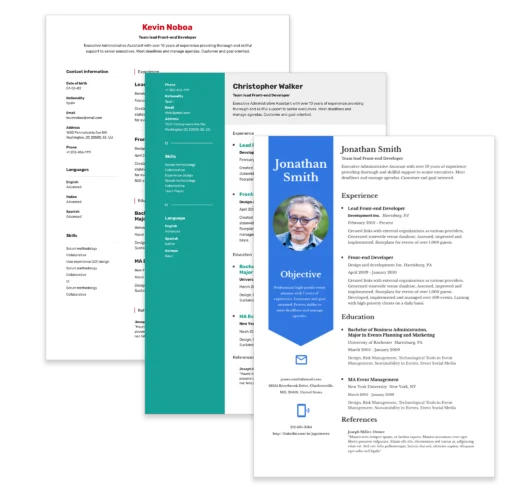
Build an Effective Resume With Our Templates
Taking the big step from high school or college to the working world can be a stressful one. Avoid the uncertainty and confusion of writing a resume for the first time and get confident preparing applications for jobs with the help of ResumeGiants. Our tools are designed to take the fear factor out of this process, so you can get your career moving faster.
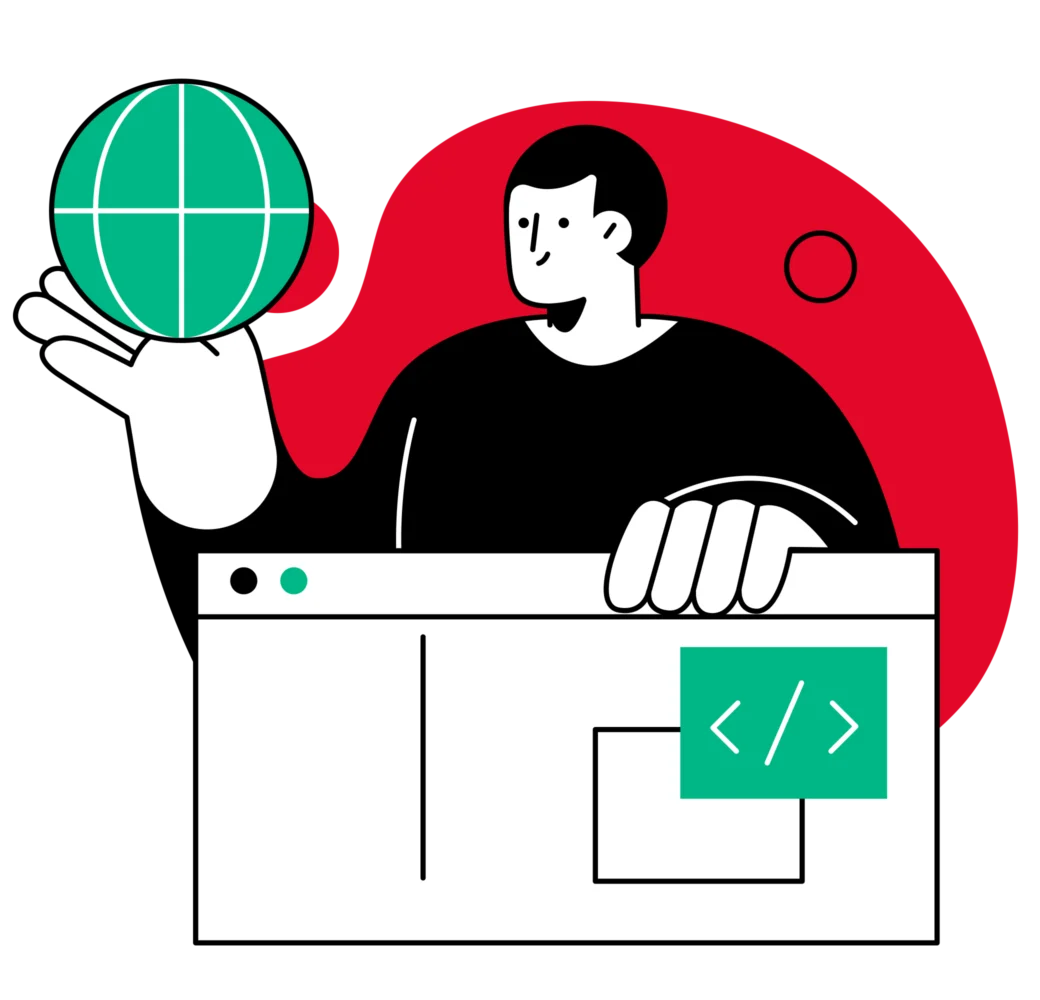
What Resume Templates Can I Use?
Free resume templates are popular online but which kind works best? We’ve taken a closer look over some of the most common types you may come across to find out.

High School Student Johanesburg
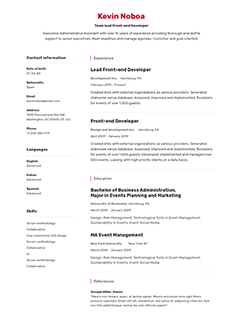
College student Omsk
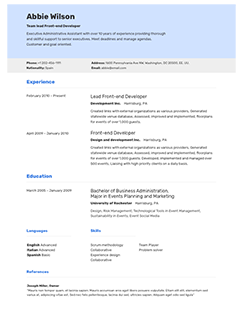
Administrator Auckland
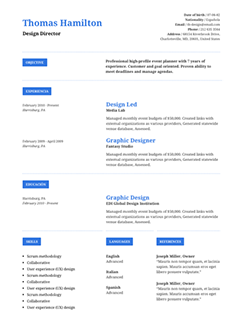
Word Resume Templates
Microsoft word has long been the king of word processing and a popular tool for resume writing. Over the past decade, the developers have added a number of specially prepared simple Word templates that you can use to drop your information into a resume layout.
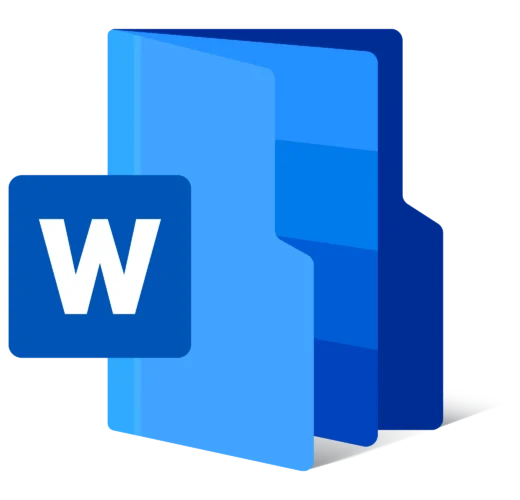
Google Doc Resume Templates
Like Microsoft, Google has also prepared special resume templates for Docs. These can be accessed from Google Workspace, Drive, and Google Docs using your web browser and all you need to do is edit the predesigned template with your own information.
Our online Resume Builder comes with extra capabilities
- Editor available in 13 languages
- Create s everal resumes and cover letters
- Secure permanent storage
- Usable on a variety of devices
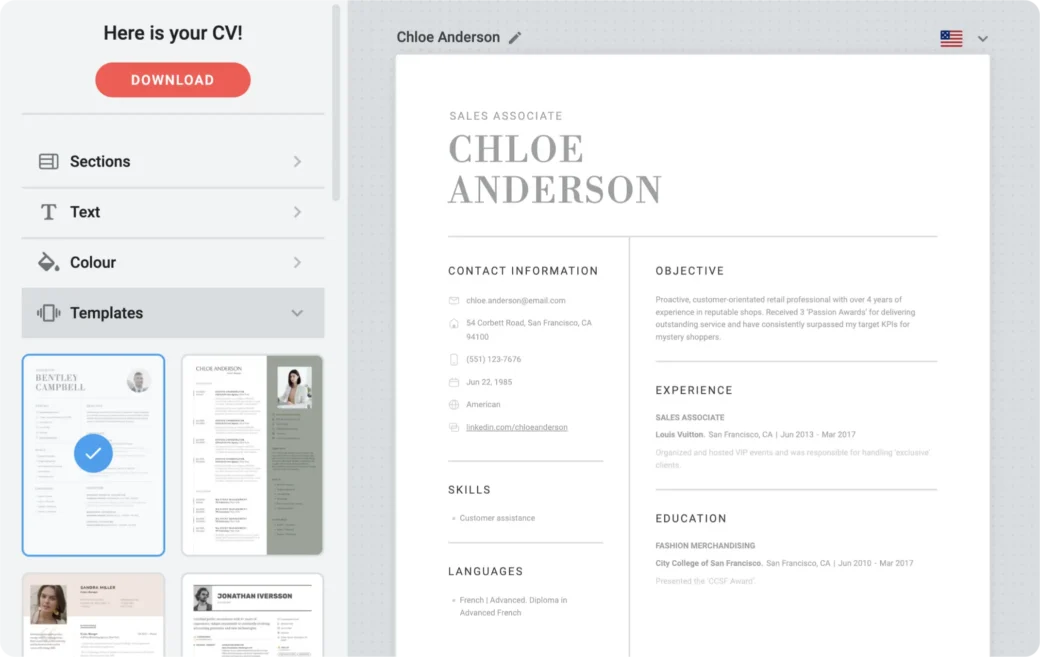
Interesting templates for students

Interesting templates by design
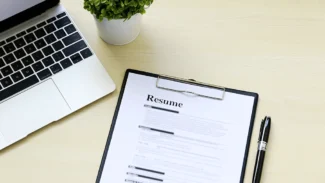
Struggling with Resume Writing?
Ease the process with our templates
Thanks for using our free templates!
Enjoy ResumeGiants? We’d love it if you’d leave a review – it’d help others!
We hope we’ve helped you to move closer to your dream job. Have you found our resources helpful? If so, share your experiences with others – leave a review! (10 seconds max)
First Online Resume Builder Powered by Artificial Intelligence
Creating a modern and sharp resume has never been easier! Innovative AI resume builder helps build your resume just in a few clicks. Don’t lose your chance to land a job of your dreams.
Why Should You Give Resume Builder a Chance?
Resume builder is perfect for you if:
- you want a professional resume
- you have weak writing skills
- you don’t know how to write your first resume
- you don’t understand what resume format to chose
- you have no time for writing a perfect resume
- you have no clue what to add in a resume skills section
- you don’t know what experience to highlight
- you don’t receive calls back from recruiters
How Does a Resume Generator Work?
What our clients say about our free resume builder.

Frequently Asked Questions
What is special about free online resume builder.
Skillroads is an expert resume builder created for anyone searching for a job with the purpose of making this process much more easier and less stressful. With our smart free resume generator, it’s possible to build a resume without any help. It's only a tiny fraction of your time that is needed — our AI will do all the work. Looking for a way to improve your resume? Our resume builder allows you to do it quickly and for free with a watermark. Make your resume right now and start looking for a new job today to succeed tomorrow!
How Can AI-Powered Online Resume Builder Help Me in Landing a Job?
Having proper application documents is of utmost importance to success in the job search process. Hiring Managers are attracted by appealing resumes and convincing cover letters. For most people, resume building is a challenge since they do not possess enough time or skills to develop a compelling resume and cover letter. That is why we launched this project. Our cover letter, resume/ CV builder creates outstanding application documents without any help to hook the recruiters and make them hire you.
How Does Free Resume Builder Work?
Creating a resume is easy with Skillroads’ free resume builder. Build a resume in 3 steps:
- Fill in a short questionnaire
- Wait for several minutes and click: download it!
Your application package is ready to pass the Applicant Tracking System and impress recruiters.
In case you wonder about the technical side of our resume generator, we can easily explain you all the workflow. Skillroad is using an AI system for the resume builder, which our technicians have taught on thousands of resumes. To be precise, we've analyzed over 5,000 resumes coming from different backgrounds, job spheres and education levels — everything to make a resume suited to your experience, background, and needs.
Three Major Reasons Why You Need Our AI Resume Builder?
Whether you struggle to update your resume or write it from scratch, or maybe cover letter writing is not a thing you are good at, do not worry. Our CV generator gets you covered.
- Innovative approach Demand breeds supply. We understand the importance of application documents for job search success. Recruiters pay more and more attention to resumes and cover letters. Some people don’t know how to create a compelling and selling resume/cover letter, so we decided to launch an online resume generator with brand new technology applied to help other people on their way toward a dream career at no cost.
- Quality guarantee We have created not only cutting-edge technology, but we also ensure you make the most of the cooperation. We value our reputation, and our goal is to see to it that client gets the service deserved.
- Application documents that sell Skillroads is a perfect choice if you are looking for a resume that would stand out and really impress your employer. We have made this service to empower the people who look for a jib all around the world, providing them with an opportunity to get a career they dream of. To fulfill this promise, we invest in our technical team to continually educate AI. We are proud of what we are doing; 97,4% success rate speaks for itself.
Where can I find a good resume builder? Resume builder: what is it, how it works, and what's the point of using it?
Creating a resume is the ultimate starting point of your career. It is essentially your entry into the career-building process, something that can define a sizable part of your life. In other words, the way your resume would look and feel is a really important document. That's why there is an endless supply of guidelines, articles, and even entire resume-building courses. On the surface, the resume can seem a rather simple task to do: just outline the info about you, your expertise, and your previous experience. Seems like some pretty simple stuff, isn't it? So, you might ask: Why do I need a resume builder to make it? Let's dive deeper into the world of resumes and find out!
What is a resume builder?
In essence, a resume builder is a software or a tool that can help you construct a resume easily. They come in thousands of different forms — from a simple resume creator that just makes a nice structure, presenting the information in your resume nicely to the complex services, where real people work to create you a resume. As you have probably noticed, there is software for resumes, and the resume services . Sometimes, it may be something in between a service and a tool. How are these two types of resume builders different? Actually, the main difference is in the following: the tools are creating your resume automatically, while services involve people. However, that's not to say that one is better than the other — it depends on which type of resume you want and what part of it you are struggling with. Resume builders usually include the pre-designed templates, cover letter structures and generally the stuff mostly associated with the visual aspect. On the other hand, resume services are centered around the content and presented to your future employer. However, they can manage the visual aspect as well.
Is it OK to use a resume builder?
Absolutely yes! It's a great choice if it is your first resume or when you make a cover letter . On the other hand, it is possible that you have a lot of information that you want to mention in your resume, and an online resume builder can help you sort it out. You can use a resume service to wipe out all the unnecessary stuff, leaving only what's essential. As you can see, there's quite a lot of situations in which you might need a resume builder. However, there are also certain precautions connected with using various types of software in building your resume. While the simple resume creator can create a resume based on your data, the problem is that it might look really bland and generic, which probably is not something you aimed for when you made a decision to use the online resume builder. So, the way to make using a resume builder OK is to treat it as an assistant, giving you fresh ideas or interesting solutions. Resorting to common templates may be seen by the HR department as a lazy and uninspired move, and such things are not taken greatly by most employers.
So, what is Skillroads?
Skillroads provides high-quality services for resume writing, ranging from beautiful resume design to working with the content, creating better, elaborate resumes that will differ from the others. In the process of resume creation, we pay attention not only to the uniqueness and visual appeal but also to put the relevant keywords for the Automatic Tracking System, along with using professional language, all at a reasonable price. A good resume cannot be made without your participation. So, before starting our work, we will make a detailed interview, where you can tell us about yourself, your experience, and your goals. Our experts will then combine all this information into an outstanding cv. After the work is done, you can take up to three free revisions, perfecting your cv or cover letter. Your eye-catching, perfect resume will be ready in a short time. You can download it in doc, docx or pdf file and begin searching for a job with a new resume right away..
What are the Pros and Cons of the resume builder?
Once again, it depends on the goals that you wish to achieve. Generally, both the advantages and disadvantages center around what kind of resume builder are you going to use, be it an online resume builder, a free resume builder, or a professional resume builder. However, certain things are common for all resume builders, both good and bad. Let's take a look at some of those pros and cons:
- Design. The visual part of the cv you'll end up with will most likely be on point. The majority of the resume builders offer at least customizable templates for the resume .
- Time. You can save time with your resume builder. If you need to create several different resume designs quickly, resume or cv builder service is definitely a great choice.
- Choice. There are hundreds of different resume designs and structures that you may choose from. Most resume builders allow for not only a wide choice of templates but an opportunity to easily create your own resume, sometimes even without having to download any software.
- Similarity. If you liked a particular template, the chances are that many other people also liked it. This means that you may end up with a resume that looks similar to the other applicants' resumes that was built by the same easy resume maker .
- Layouts. Sometimes, resume builders come in pre-designed layouts. In this case, if you have nothing to write in one of the gaps (for example, previous work experience),the structure in your resume may have a huge gap.
- Alternate text. It's not exactly a disadvantage, but more a common mistake that happens when using resume cv builder service. A lot of the resume builder templates already have random text inserted where your content should be. Make sure you removed this text before saving your resume and sending it to the employer!
What is the average price of resume building services?
Let's hear the good news first. The good news is that for stuff like a simple resume creator or online resume creator — something quick and basic that you can make in a matter of minutes — you can find a lot of free options. Although not all of them may give you the quality you are looking for, finding really decent alternatives is possible. However, for a more detailed, thought-out resume, you'll most likely need some professional help. The price for a professional resume maker starts from around $100. What you'll get at this cost, however, is a well-written resume that is definitely going to to impress your future employer. Some of the other professional services, for example cover letter writing or LinkedIn profile editing , can increase your check-up to around $200. However, don't be afraid to spend — after all, it's your investment into the future!
Where can I find a good resume builder?
There are a ton of various resume builder services available. In fact, it's quite easy to get lost among them, not knowing what to choose. Do you need a cheap resume builder or something more sophisticated? What is more, there are certain resume creators that may not have a decent quality, which complicates the question even more. Is there any way to deal with it? Actually, you have several options. Let's look further into them. The first thing you can do is to look at some of the reviews left by other users. They can give you an impression of what the resume builder you want to use is like. Another great option you have is to order a free sample from the resume builder you chose and check the result by yourself. For example, you can try to order a sample from our service. But before you do so, let's look at some more info about it.
Resume builders is quite a huge topic, isn't it? We really hope that now you know a little bit more about them and how they can help you jumpstart your career. Whether you'll choose a simple resume builder, professional resume writing services, or even an AI resume builder, remember one thing — after all, it is you who are the center of your resume. So, no matter what method you use, with the right approach, you'll be able to shine! And if you feel like you could use a little help — our service is always here to support you in the resume building process.
'ZDNET Recommends': What exactly does it mean?
ZDNET's recommendations are based on many hours of testing, research, and comparison shopping. We gather data from the best available sources, including vendor and retailer listings as well as other relevant and independent reviews sites. And we pore over customer reviews to find out what matters to real people who already own and use the products and services we’re assessing.
When you click through from our site to a retailer and buy a product or service, we may earn affiliate commissions. This helps support our work, but does not affect what we cover or how, and it does not affect the price you pay. Neither ZDNET nor the author are compensated for these independent reviews. Indeed, we follow strict guidelines that ensure our editorial content is never influenced by advertisers.
ZDNET's editorial team writes on behalf of you, our reader. Our goal is to deliver the most accurate information and the most knowledgeable advice possible in order to help you make smarter buying decisions on tech gear and a wide array of products and services. Our editors thoroughly review and fact-check every article to ensure that our content meets the highest standards. If we have made an error or published misleading information, we will correct or clarify the article. If you see inaccuracies in our content, please report the mistake via this form .
How to use ChatGPT to write your resume

Back-to-school season is here, which means applications to their next academic ventures, internships, or first jobs are top of mind for many students. Whether you're seeking to launch your career or you've been in the labor market for decades, there's one thing we can all agree on -- creating a resume that attracts the eye of recruiters is a challenge.
How to use ChatGPT to write: Cover letters | Code | Excel formulas | Essays
Landing a job that aligns with your qualifications and expectations is hard enough. You also have to sum up all your professional experiences and strengths in one application -- and the heart of that application is your CV or resume.
The ideal resume is a concise one-page document that highlights your academic, professional, and leadership achievements, which is just as difficult to assemble as it sounds. OpenAI's ChatGPT can make the resume-building process a breeze.
How ChatGPT can help build your resume
You can use ChatGPT to generate ideas and bullet points for your role from scratch or to refine and optimize your current points that are not hitting the mark. Beyond key points, the AI tool can help you answer questions about putting together your resume. Here's how to get started.
Side note: We are using ChatGPT, but you can use any AI chatbot -- there are plenty of capable AI chatbots to choose from .
1. Choose a resume template
ChatGPT will help you with the text in your resume, but you'll need to pick a template before you get started. The program you're using to write the resume -- such as Google Docs, Microsoft Word, or Canva -- will likely have a resume template already.
Also: How to use ChatGPT to digitize your handwritten notes for free
A quick Google search for resume templates will also bring up hundreds of editable templates you can import into your program of choice.
2. Sign in to ChatGPT (optional)
On April 1, 2024, OpenAI stopped requiring you to log in to ChatGPT. You can now access ChatGPT simply by visiting ChatGPT's website . However, if you want to take advantage of certain perks, such as being able to revisit the chat later, analyzing PDFs , or digitizing hand-written notes , you need to sign up to access those features.
Also: How to save a ChatGPT conversation to revisit later
Signing up is easy. Go to OpenAI's ChatGPT homepage and open an account by creating an OpenAI login or using your existing Google or Microsoft account. ChatGPT is free, so the sign-up process is simple, requiring no credit cards or obscure information.
3. Add text
If you want ChatGPT to generate text for your resume from scratch, all you have to do is ask.
Whether you want it to generate your professional summary or an individual bullet, ask it directly. For example, I asked ChatGPT, "Can you write a short, professional resume summary about my role as a tech reporter?" Within seconds, it generated what you see in the screenshot below.
Also: How to get ChatGPT to browse the web for free
Although ChatGPT can create content ready to be copied and pasted into a resume, you should tweak the text so it is personalized to your experiences and doesn't look like a chatbot wrote it.
Employers want to learn about what makes you unique. Without your assistance, the chatbot can only access generic content about your role. You can also use the Custom Instructions feature to share some details about your role and interests that ChatGPT can reference when outputting the text to give it a little more nuance.
4. Use ChatGPT to revamp your text
Whether you fill out the template yourself before using ChatGPT's assistance or have an existing resume you want to enhance, ChatGPT is a great resource for polishing up text.
All you have to do is copy and paste your text and ask ChatGPT to make it better.
Also: The best AI chatbots: ChatGPT and other interesting alternatives to try
For example, I asked ChatGPT, "Can you make this resume bullet sound better: 'I write stories about technology.'" Within seconds, it outputted an elaborate bullet point that incorporated a professional tone and made that simple sentence more complex, as seen in the screenshot above.
Once you get your result, you can always tell ChatGPT to tweak it further with prompts like, "Make it shorter" or "Can you include [additional details]?"
How much does it cost for ChatGPT to write my resume?
ChatGPT is currently free to use regardless of what type of writing you use it for, which includes resume-building assistance.
How can ChatGPT help me with my resume?
ChatGPT can generate text for different parts of your resume, including your professional summary and individual bullet points for each experience.
Also: How to nail the 'Do you have any questions for me?' part of the interview
The chatbot can also help enhance your current resume by optimizing your text. If you have any questions about how to format your resume and what to include, ChatGPT can give you some answers.
What should I put in my resume?
Ideally, you want a resume to highlight all your career accomplishments. This can include any educational, professional, and leadership experiences that are meaningful to you. You should also include as much detail about your unique experiences to make you stand out from other applicants.
How I test an AI chatbot's coding ability - and you can, too
Should you use ai to build your resume 64% of hiring professionals approve, how to use chatgpt to analyze pdfs (and more) for free.

IMAGES
VIDEO
COMMENTS
Don't create your resume from scratch. Use one of our proven resume templates and kick start your search from the beginning. Build a resume with a template. Create your resume in minutes with Indeed's free resume builder. Download it to your computer or use it to apply for any job on Indeed.
Create Resume. Choose a resume format carefully. In 99% of cases, we recommend the reverse-chronological format. Add the right contact details. Leave your headshot out and make sure to include your job title, a professional email address, and any relevant links.
To make a resume that fully demonstrates your experiences and goals, it's important to be strategic with the language, format, and sections you include. In general, there are three broad steps to making your resume: Identifying keywords and important skills. Choosing a format. Writing each section. In this resume guide, we'll offer tips and ...
Related: Resume samples and templates to inspire your next application. 2. Include your name and contact information. Your resume should begin with your name and contact information, including your professional email address and phone number. You have a choice about whether or not to include your mailing address.
Image description. Follow these steps to build your resume: 1. Add your contact information. The first item on your resume should be your first and last name, a phone number and an email address. Consider also including additional contact information so potential employers have several ways to reach you.
5. Don't Forget Your Education. If you're still in school or just graduated, your education can go at the top of your resume, but for pretty much everyone else, this goes near the bottom. Most people include their school, graduation year (for folks less up to about a decade out of school), major, and degree.
Yes. When you use our Resume Builder and Cover Letter Builder, you can access 15 template bundles to help match your resume and cover letter. Using the same template style for both documents helps impress employers. Head to our cover letter templates library to see the matching template bundles.
Build My Resume. Our free-to-use resume builder can make you a resume in as little as 5 minutes. Just pick the template you want, and our software will format everything for you. 2. Indeed Resume Builder. While Indeed is mostly known as a job board, they also provide one of the best free resume builders online.
Build a professional resume in minutes with Resume Builder, a free tool that offers expert guidance and 30+ templates to impress recruiters.
100% free resume builder to make, save and print a professional resume in minutes. Make applying faster and easier by connecting to millions of jobs today.
Resume Builder offers numerous resume creation solutions for your career needs for only $2.95 during the 14-day trial period. Our application infuses AI-powered technology and writing methodologies from certified resume writers to help you build and customize your resume and cover letter. Below, you'll find our pricing options:
Resume Builder Use our builder to create a resume in 5 minutes.; Resume Templates Find the perfect resume template.; Resume Examples See perfect resume examples that get you jobs.; Resume Format Choose the right resume format for your needs.; How to Write a Resume Learn how to write a resume that lands you jobs.; Resume Help Use our expert guides to improve your resume writing.
Here's some resume tips and tricks for this section: 21. Put experience first, education later. Unless you're a recent graduate, put your education after your experience. Chances are, your last couple of jobs are more important and relevant to you getting the job than where you went to college. 22.
Get 3X more interviews than your peers ‡. Create resume. ‡ Results derived from a study responded by 1000 participants of which 287 created a resume online. Try the best resume builder online. Choose an ATS-friendly template, add ready-made job-specific phrases, and download your resume today. It's that easy!
Make your resume fast with our AI-powered resume builder. Generate bullet points instantly and quickly format your resume in HR-approved templates. ... Not only does the Genius AI resume builder help you generate quality content for your resume quickly, it also formats it into attractive, HR-approved templates so you can start applying to jobs ...
Why we chose it: Besides the smooth resume-creating process, Zety provides you with a personalized resume score to help you improve your weak points.. Zety is an online resume builder tool that comes with several premade templates including templates designed by the company's "Certified Career Experts." The resume-creating process is quite simple and straightforward as Zety guides you ...
Create your professional resume with this online resume maker. Choose a designer-made template and grab any employer attention in seconds. ... Ready to use templates that will help your resume stand out to recruiters. Easy-to-use platform. Create your job winning resume and start your job search! Online Resume Builder. Create a perfect resume ...
AI resume writer, powered by ChatGPT. Enhancv wraps the power of ChatGPT in a quick interface that ensures you can focus on creating a resume, rather than switching between tools. Fine-tuned to deliver professional suggestions, the Enhancv ChatGPT AI assistant takes you one step closer to the next step in your career.
The same applies to your cover letter. It is your chance to provide more detail on how your experience will help you succeed in the job. Read our cover letter guide for how to write one that makes you stand out. 3. Decide how to format your résumé. Most of the time, a chronological résumé will work well for communicating your past experience.
Build an Effective Resume With Our Templates. Taking the big step from high school or college to the working world can be a stressful one. Avoid the uncertainty and confusion of writing a resume for the first time and get confident preparing applications for jobs with the help of ResumeGiants.
Follow 6 easy steps. To build a resume, follow our simple steps. Indicate the basic info regarding your education, job history, career expectations and soon, you will get a quality resume. 5 minutes. 03.
It shows the recruiters that you have the qualifications they're looking for. Knowing how to put skills on your resume is an invaluable skill that will help you propel your career forward. To learn more about skills on a resume, I analyzed over 93 thousand resumes created in our builder by professionals holding over 2,500 different job titles.
Let's Eat, Grandma - Best Resume Builder for Range of Career Service. Star Rating: 4/5. Let's Eat, Grandma is an inventive and progressive tool for creating impressive resumes. The platform ...
How ChatGPT can help build your resume. You can use ChatGPT to generate ideas and bullet points for your role from scratch or to refine and optimize your current points that are not hitting the mark.
Vermont Employment Pathfinder will help best match users with career opportunities by creating a resume, identifying applicable jobs and applying for those jobs.
Meet on-campus employers and local businesses looking for part-time employees. Bring your resume and class schedule for employers to look over. Before the event, stop by Career Engagement, Memorial Student Union Building #122 (across the hallway from Starbucks) to help get your resume looking sharp., powered by Localist, the Community Event Platform